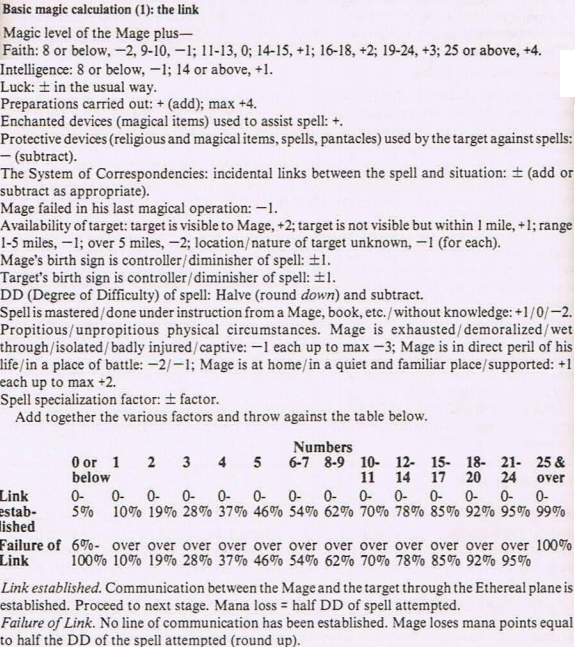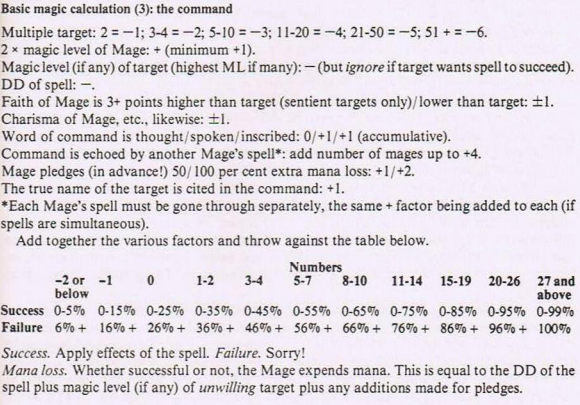Fantasy Wargaming: The Highest Level of All by Mystic Mongol
Prologue
Original SA post
Back when I was a younggun, my dad was very supportive of my oddball habits. Not that he really understood them--but he was going to be
supportive
, dammit! And so one day he bought me this at Philcon. After he picked this up for me, we came to an understanding--he didn't have to be supportive any more.
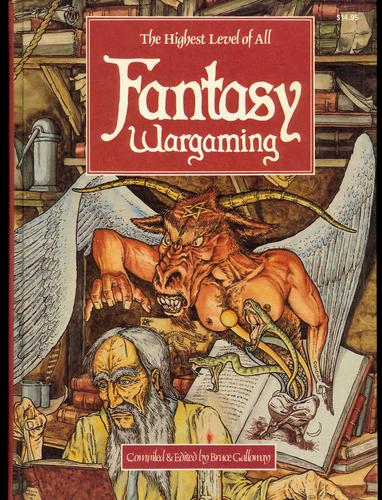
Published in 1980, it's a small hardback book, all text with the occasional chart or woodcut. The charts have no lines, but do occasionally feature bold words. For a book where the first three chapters are all setting information, it oddly contains no clear campaign setting (it's England at some year or other, or maybe you're vikings or welsh or something). It also explains that while a wide and varied party might be more
exciting
, a band of military men or knights is a much more realistic choice, because Fantasy Wargaming (The Highest Level of All!) is nothing if not historically accurate.
Did you know that God, Lucifer, Heimdall, and Sif all have Leo as their astrological sign!? This is why God has bonuses to his physical strength and social status, but a penalty to his religious faith. All the data is pretty useful once your character dies--refer to some charts and find out if you're going to heaven (stop committing sins for two days before you die and you're a shoo-in) or if not, how many centuries you're spending in Purgatory, or what circle of hell you wind up on. Unless you're a Viking, of course. Then you consult the tables to see if you wind up as a god--or, if female, a Valkyrie.
Of course, in Fantasy Wargaming, females would make pretty terrible Valkyries, because--well, we'll get to that in time. For now, let's just say you
wish
it was -4 to strength.
Historical accuracy!
Prologue: Revelation
"In which all is revealed"
quote:
So what is fantasy wargaming?
If you have picked this book up, chances are that you don't know and would like to, but are put off by the sheer complexity... of the many commercially imported games and rule books available;
The introduction goes on to talk about how great roleplaying wargames are compared to mere strategy wargames, and how great it is to be able to play knights, witches, wizards, priests, or brazen harlots. But Dungeons and Dragons is apparently pretty punk--for one thing, dungeons are stupid and don't make sense. Also, having a party made up of knights, witches, priests, and brazen harlots is dumb--why are they hanging out together? And who cares about some stupid alternate earth?
Clearly, the introduction asserts, it's better to play a roleplaying game with strong character motivations, realistic character roles, a flexible combat system that cleanly converts to mass combat rules for clashing armies, a strong grounding in real world religions and history, simplified rules for fast and easy play, and ultimately bring across the 'feel' of being an actual resident of the Dark Ages. And that's just what Fantasy Wargaming has done!
I assure you, playing this game certainly feels like dying of the plague.
Chapters 1-2
Original SA post Fantasy Wargaming: The Highest Level of AllA depiction of a bustling city larger than 99.9% of the locations in setting.
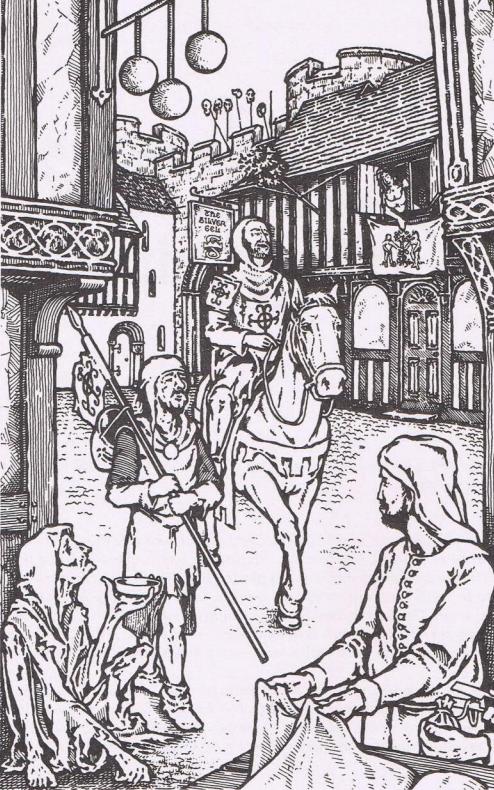
Chapter One: City, Court and Country
(or, "God is Groat")
This is the first of several setting chapters. As Fantasy Wargaming is set in medieval Europe, and mostly in England, there's a lot of material about how much it sucked to be a dirtsquabbling farmer, and how everyone who wasn't involved directly in the production of food was a tremendous oppressive asshole.
It also talks about how many hamlets were in the middle of friggin nowhere, tiny farming communities based around the small patches of fertile land. Almost completely cut off from the rest of civilization, even from the nobility who supposedly ruled them, they were often the havens of groups of pagans, heretics, bandits, outlaws, or Devil worshipers, and that this makes them a fine place for adventure. Cool!
Then there's three and a half pages about where individual slave serfs can keep their pigs(where they're told!), how many of them die of malaria(everyone) and how a peasant can escape being a peasant (join the church, be a bandit, or run away to die in the woods alone). Also, almost everyone is a slave, and no one gives a shit about your deeds or accomplishments, only how much land you own. There are high adventure settings, there's gritty warfare settings, and then there's Fantasy Wargaming, where the book says if you don't struggle with dysentary, cringe when a noble passes through, and warm your hands in your own poo, you're doing it wrong. All in all, it's a very compelling argument against historical accuracy.
The rest of the chapter is a short but jaw-achingly dull lecture on the Middle Ages and Dark Ages. Because the setting spans two major time periods and supposedly every country in Europe, there are no specifics or interesting facts about the people or places you're likely to encounter in the game. Instead, it's a brief socioeconomic lecture on just how much it sucked back then--a large town might have 600 people total, everyone was always diseased, the nobles owned everything but provided no stability because there was no oversight, and everyone did whatever they could get away with. The only court of appeals available was the church, which for the most part was just as corrupt as the nobility only with different people on top and more lip service to god. All legal systems and servants were basically dudes with clubs who would hunt down troublemakers and beat / kill them, with varying levels of authority over one another. Chivalry is a lie told by nobles to other nobles to make them feel better about hurting people, and Santa Claus has caught the Bubonic Plague and died.
Most notably, except for the offhand mention of how hamlets are good for adventure, and how a GM can decide to have more than a realistic amount of Chivalry in his game, the chapter is completely free of advice on using any of this material in a game, or how it could springboard into adventures, or what kind of challenges a Justicar of the peace and his club wielding minions could expect to face, or anything else useful for a role playing game.
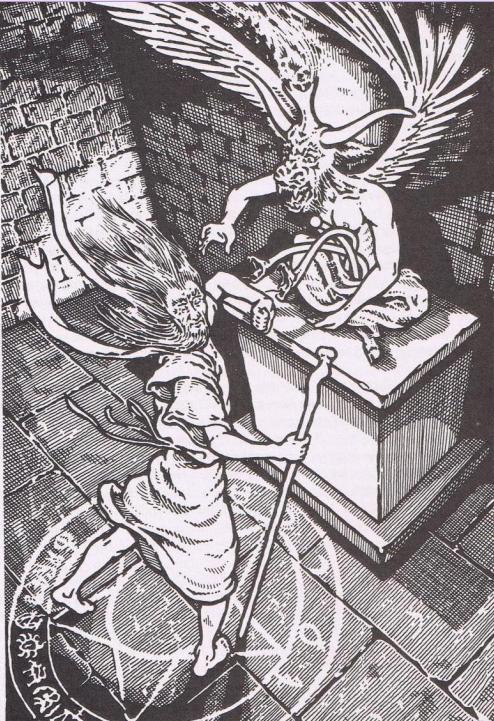
A powerful wizard is attacked by the terrible demon Does Not Appear In This Book.
Chapter Two: Myth, magic and religion
(or "Mana maketh Man")
This chapter kicks off with a long and rambling explanation of the supernatural and how it can possibly fit into a 'historically accurate' game without making it historically inaccurate. I will sum up:
pre:
Magic flows through us all--it is the breath of life, and the fundamental power of the universe. Things and places and ideas and people and fundamental forces can all be enchanted. It works because people believe it does, and thus is belief taken form and strength. But not normal belief, thinking you have food in the pantry doesn't put food in the pantry because of Gods and demons exist because we feed them with our belief, so they actively try to promote belief. This has no effect on society.
Also, because people believe in them, the Devil and the gods of Asgard are all real and give their followers terrible magical powers. Again, this has done nothing to change society or the world at large.
quote:
Chaos, Neutral, Law
Previous fantasy gaming rules have tended to take from Moorcock there nebulous terms as meaningful divisions for magic users. It is, however, impossible to relate these in any useful way to the historical cultures in Fantasy Wargaming--although at least one other game has tried. Nor can "Good," "Neutral" and "Evil" quite be made to fit the bill.

Yeah, but those Norse Sorcerers are totally useful to understanding the historical Teutonic cultures, you asinine fuck.
It's not all bad, he's got some lines in here which are mildly amusing even as they're theologically, historically, and just generally confusing. In the section on Teutonic gods not being jealous of worship and tolerating someone worshiping them and the Christian god at the same time, "Thor didn't mind in the least (although it's reported he once challenged Christ to single combat, an offer our Savior politely declined)". What, were they hanging out at a bar or something?
All the afterlives exist side by side on the Ethereal Plane, which is handy if you have Jewish friends and want to hang out after you die, I suppose.
Then there's several pages on terminology, all explained in the most confusing ways possible. Is a given spell peasant, noble, or hedge magic? Black or white magic? Is the term necromancy period appropriate? What's the difference between a sorcerer and a witch? Can spells taught by the fey be considered fairy magic? How does bardic magic differ from normal magic? Spoiler alert, None of this matters even a little in Fantasy Wargaming .
Finally, it talks a little about the kind of miracles that saints cause. And here's a miracle, even though magic is a relatively common force that anyone can use with training, the miracles caused by saints have not changed even a little! They're still mostly food creation and curing droughts, not smiting heratics with enormous pillars of golden flame. And everyone's still impressed! There are no guidelines for how they can be used in adventures or how they can move a plot, but there is the following line about divine motivation,
quote:
God doesn't mind showing off if there's a large catch of potential mana to be culled from the operation, but generally the mana expended on a miracle of walking on water or raising mountains will not justify itself in a cost-effective way.
The greatest miracle of all, God's presence, has been reduced to a cost-benefit analysis matrix.
Next time: More vague historical facts with no guidelines for use at the gaming table!
Chapters 3-4
Original SA post Fantasy Wargaming: The Highest Level of AllMore of the same!
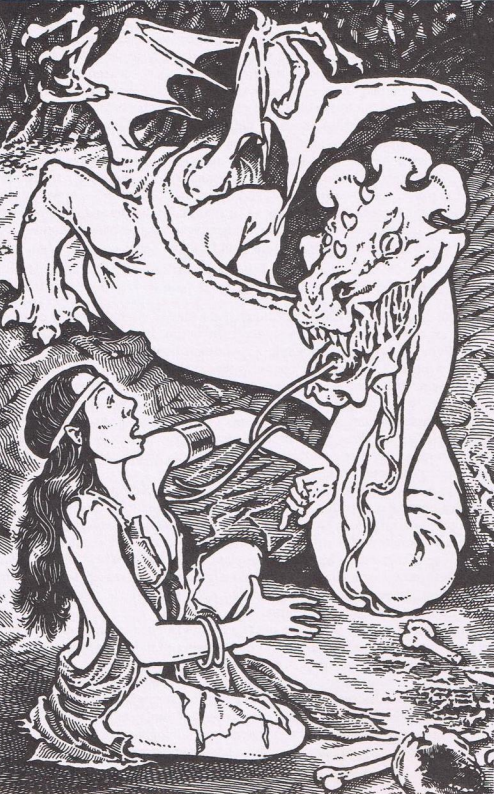
This game contains only trace amounts of elves and dragons.
Chapter 3: The Book of Physiologus
(or "Oh god! It's a Thesaurus!")
See that picture of an elf getting molested by a dragon? That picture takes up considerably more room in the book than the rules for elves and dragons does, way in the back. There are no rules for playing as either.
The chapter starts by promising to introduce the "marvelous menagerie of monsters and mythical beings that were, to the medieval imagination, at least as real as the elephant and the tiger, and in many cases more believable than the fantastic attributes then ascribed to many bona fide forms of exotic wildlife." I guess since humans believe in them they exist. But if that's true, why do wizards have to cast spells instead of just being crazy people who believe that trees talk to them and they can fly if they jump off the roof? That question is never answered.
The only good part of the Chapter posted:
Naturally, we don't want to inhibit GMs' invention in this field, and we would urge them to be as free as they want in their resort to anachronism or other departures from strict authenticity. After all, when you're dealing with creatures who never trod this earth, it doesn't matter much whether you locate them in Madagascar or Shropshire.
Awesome! Finally some advice for running the game! It came immediately after the author complained that all modern monsters are shoddy knockoffs of awesome medieval monsters, but still not bad. Not great, either. We made it to chapter three, and all we have to show for it is this and that comment earlier about hamlets being a great place to have a evil organization.
But again the book immediately forgets it's a role playing game, and turns back into a dry, not terribly interesting paper on medieval culture. The book makes a difference between the monsters peasants believe in (literary monsters) and the monsters from ancient Greece that the monks, scholars, and other nerds believe in (scholarly monsters). Muddying the distinction between these two is the fact that both types exist , what with this being a fantasy setting, and you can go hunt, kill, stuff, and mount one for display.
Then it begins describing individual monsters. Few rank more than a paragraph or two--barrow wights are ghosts who haunt graves, frost giants are big guys who don't trust the asguardian gods (They all live in Jotunheim? Isn't that on the Etheral Plane? So who cares?) and so on, long, dusty paragraphs of flavorless description containing nothing of interest and no instructions on using them in a game.
An example. They could talk about how Dwarves are constantly at odd with the craftsmen guilds because they make the finest products in creation and you can pay them in milk, so there's really steep import taxes on dwarven goods. Smugglers and bandits do a brisk trade in dwarven steel, and because it's all criminal some of it is fairy metal that bewitches people who use it too much and draws them into the fey realm. Right there I've given seeds for adventures revolging around smuggling, stopping bandits, tax collection, vicil unrest, industrial monopolies, magical brainwashing, oppressed minorities, economic warfare, and cross-dimensional human trafficking, but Fantasy Wargaming isn't a book about running a compelling role playing game, it's a dull book about medieval Europe.
Even more damning is the short section on elves.
quote:
The Norsemen called them alfar, the Anglo-Saxons ylfe, and the Snorri Sturlusson tells us that there were two species, the Light Elves of Asgard and the Dark Elves who dwelt on the Earth or in what was to become Faery.
It goes on for a while, but I don't care. What I'm annoyed at is the fact that earlier he says these monsters and non-human races exist because they are believed in, like the Gods and magic and such. But if the different ethnic groups believe in four different races, with presumably different powers and behavior, why do they manifest as a single race? And if belief doesn't matter for the Elves, why does it matter for the other monster races? Why does it matter for God, who's wandering around looking for favorable investment opportunities to promote his brand without expending too much accrued belief capital ?
The answer, of course, is that the belief explanation is just one tacked on top of the system by the authors. They gave it no thought, spent no effort trying to figure out how the world and the people and monsters in it would be affected by this change, and have spent no effort at all adapting the material to be workable at the table. The entire book is an exercise in intellectually dishonest academic masturbation, with the first three chapters dedicated to a setting they haven't spent any time on and probably don't care very much about.
The chapter ends with a short explanation of the undead, (dead things that still move) and the fact that vampires aren't undead, they're an east European monster that can take human and animal shapes, bats not inclusive.
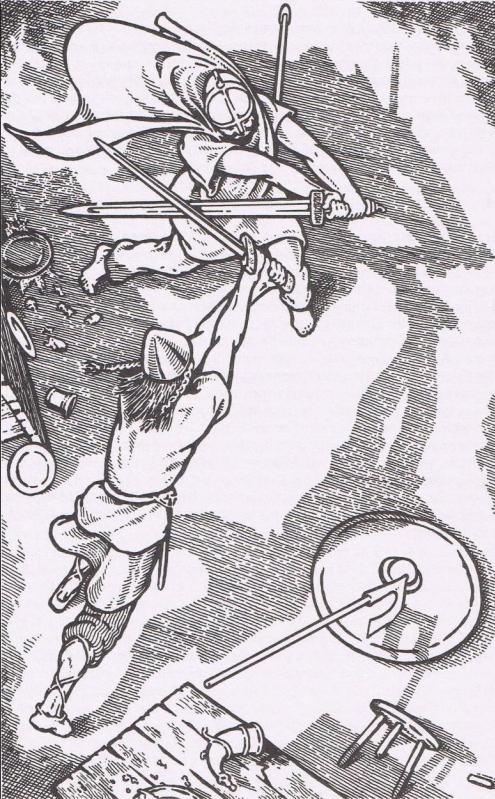
This picture is pretty sweet.
Chapter four: Mortal Combat
(or "A poignard in your codpiece")
Who wants to dig into the actual rules? Too bad! This is more setting information.
I'm just going to breeze through this whole useless chapter. It's only nine pages long, including two pages of pictures and two pages of glossary, and is a description of the weapons, armor, army layouts, and castles of the period.
All four of these classes of objects share the following facts: One, Fantasy Wargaming describes how they have changed through medieval history. Two, all descriptions are free from anything interesting, and consist of dry flavorless facts. Three, there are still no rules for effectiveness or cost, making this another chapter completely useless for Wargaming in a Fantasy setting, which is what we're supposedly here for.
Next chapter: No rules yet!
Chapters 5-6
Original SA post Fantasy Wargaming: The Highest Level of All
Another scene unsupported by Fantasy Wargaming
Chapter five: Moorcock and More
(or "Whatever takes your fantasy")
Dungeons and Dragons had appendix N, a list of the authors and fiction that shaped his love of fantasy and influenced dungeons and dragons. Fantasy Wargaming goes further with chapter five, six pages of the fantasy that influenced the author and why it is not as good as a totally sweet campaign.
He actually speaks pretty highly of Tolkien, saying it's pretty much already a fantasy world mored in a real world cultural past, and about as deep as the depth he's hoping that you will create with the help of this book. Then he says it's a crappy setting for a game because Tolkien has done all the work for us and if you want to do anything that's surprising or interesting you have to introduce non-canon elements.
quote:
I first read Lord of the Rings in 1960, long before the book had become a fashionable cult,
You smug hipster fuck.
Anyway, while we're supposed to try to make a game world as deep as Tolkien's, apparently we can learn more from the other authors, and so he lists a bunch of other fantasy writers. In some cases explains why they're not as good, and in every case he explains that he read them in the original hardback before they were popular. Most of it is pretty dull, a decent enough summary of popular fantasy works at the time, but for someone who claims to be at the cutting edge of fantasy he hasn't read a single thing I haven't heard of.
And then there's Gor .
quote:
For heaven's sake don't let a "liberated" wife or girlfriend read them, though, or you'll never hear the end of it!
I am mad! Mad about role playing games!
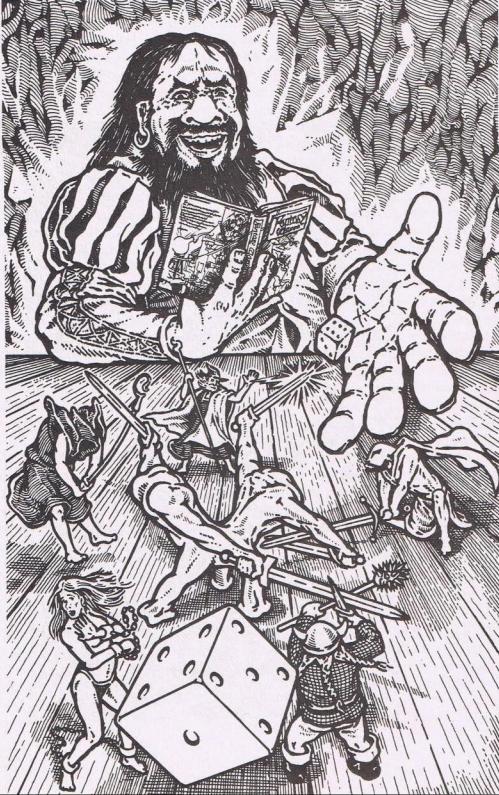
Nothing gets me harder than throwing dice at cowering, submissive women!
Chapter Six: The Complete Enchanter
(or "What in Hell do I do Now?")
Finally, he remembers he's writing a game book! This is the GMing chapter, and it explains how to run a game of Fantasy Wargaming sucessfully.
Things this chapter does not contain: Guidelines for giving out exp, guidelines for appropriate challenges, adventure seeds, pacing, motivation, rewards, campaign goals, or faction politics. What it does contain, indeed what takes up about half the chapter, are instructions on making a dungeon. It has suggestions for making a solid backstory by drawing from the legends and history of your neighborhood, then taking inspiration from interesting looking architecture before you take pencil to A4 graph paper and map out the wandering passages. Room descriptions should be written out, a brief description of any monster and it's stats should be in your notes for easy reference, and so forth. If there are any documents or maps found in the dungeon, write them out to hand to the players--you all know the drill. It also says the GM should prepare an appropriate wandering monster table, because there's nothing that spells versimilitude like randomly spawning encounters. Finally, remember mechanical traps are not historically accurate, so don't use them.
This would be a pretty good section, except for the fact earlier he said dungeons make no sense and you should have your adventures set in historically appropriate settings like hamlets full of satanists .
There are no guidelines to help with writing a hamlet adventure.
There IS a section about not letting the players do anything for convenience.
quote:
A ploy by players which you should not allow, is to say a general order, that they are feeling for secret entrances, checking for traps, tapping for hollow walls or similar actions and assume they are doing it all the time. Unless a player states specifically, at a particular time, that he is carrying out that sort of action, you have every right to assume he is proceeding with only normal vigilance. He will notice anything glaringly obvious, but subtler things will escape him. . . . This also conveys the advantage of benefitting the careful, thoughtful player, while penalizing the "thud and blunder" merchants.
Ignoring the fact that he said traps are historically inappropriate and you shouldn't use them, why does he want to force the players to repeat the same five lines of action every ten goddamn feet? Playing with him must be a whirlwind of excitement.
Now, granted, this is a pretty old school book. Level appropriate encounters are not a thing yet, scaling between levels isn't well defined. This setting is all about the historical versimilitude, so fighting an array of demihumans who steadilly grow in power to mirror your own strength isn't appropriate. But so much is just missing! No discussion with players about what kind of game to run--heck, no talking about the themes of your campaign. It doesn't talk about allowing player agency--the idea that players will buck the rails and run laughing off into the hills seems to have never occured to him. Maybe if they do, he simply chides them with the fact that a historically accurate mercenary would investigate the plot hook.
Incidentally, there's noting about making good plot hooks.
Later he talks about storytelling techniques. In particular, how best to take control of the player's characters out of the players hands, because those jerks arn't going to do anything interesting with them.
quote:
As an example, in one dungeon I ran, a character released the trapped spirit of a high level female magic user, who took over his body and mind and changed his sex. I told the player that he had suffered a sex change and had picked up a few memories from the body he had disturbed because tehre was a fragmentary telepathic ability preserved with the body. The player continued to run the caracter, while I occasionally dropped hints as to "vague recollections" of this or that. The effect was of the magic user surreptitiously steering the party in the direction she desired, till at last they reached their goal and she revealed herself in her true colors, at which point I took over playing her. I escaped with all the loot, but I did leave the party with another treasure map with which to console themselves.
 Ha ha! Take that, player! You deserve to turn into an NPC and run off laughing with all the loot. Women can be tricky, am I right guys?
Ha ha! Take that, player! You deserve to turn into an NPC and run off laughing with all the loot. Women can be tricky, am I right guys?
This charming anecdote segways directly into the rules for saving throws, which are the first rules in the book. They don't get a subheading, and these rules appear in the middle of a block of text of generic game mastering technique, so this is the first time I've actually noticed them. The author tells us that we should only rarely give the players no saving throw at all, because losing their character without getting to do the dice is unsatisfying. (This is literally two paragraphs after he turns a player into an NPC and steals everyone's loot through fiat)
quote:
How, then, do you assess such a chance? A simple roll under your agility is one method, but rather crude. I prefer to set a precentage chance, and have the player roll under it with a percentage dice. This leaves us with the problem of setting the percentage. Here you have got to be really honest with yourself and your players. Assess whether there is a substantial or negligible chance of saving, or somewhere in between. If substantial, allow a chance of 35-40 per cent, if negligible, a chance of 10-15 per cent and 25-30 if in between. Modify this by 5 per cent for above or below average agility, with an additional 2 per cent for exceptional scores. Also modify by 5 per cent if the character's level is higher or lower than the level of difficulty of the dungeon. The final result is the percentage saving throw.
Couple things. One, this is the first (and probably last) reference to the dungeon level.
Second, if someone rolls a log down a hill at a dude, that means it has a 70% chance to knock him on his ass and break a leg. But if that man is the noble knight Ser Lancelot, fleet of foot, stout of heart, brave and skilled and true and the greatest knight of tyme, it only has a 58% chance to knock him on his ass and break a leg.
Why shouldn't the GM roll every die for the players?
quote:
Players are going to feel they have lost control of their own destiny. Possibly they have, but they should not feel so.
The chapter image is clearly 100% appropriate.
quote:
A vital aspect of mastering an adventure is keeping your players under control.
Wouldn't want them wrecking your game.
quote:
Characters of radically different alignment who act hand in glove with each other, should be penalized with a possible change in alignment.
Fun fact: Fantasy Wargaming does not have alignments.
Some of the advice in this chapter is not bad , exactly, but almost none of it is relevant. Yes, a dungeon master can use mood lighting, handouts, background music, and silly voices to make a game more immersive, but all of this is secondary to running a complete adventure, with a plot, motivations, a goal, an appropriate number and intensity of challenges, and player agency. And the book provides NONE of that. Hell, most of this chapter seems like it should be written for Dungeons and Dragons, not Fantasy Wargaming.
Next up: Suck a dick and get back in the kitchen, Guide to Female Gamers, real misogyny is coming through.
Chapter 7
Original SA postHeliotrope posted:
Mechanical rules that force women to act in certain ways?
Funny you should say that...
Fantasy Wargaming: The Highest Level of All
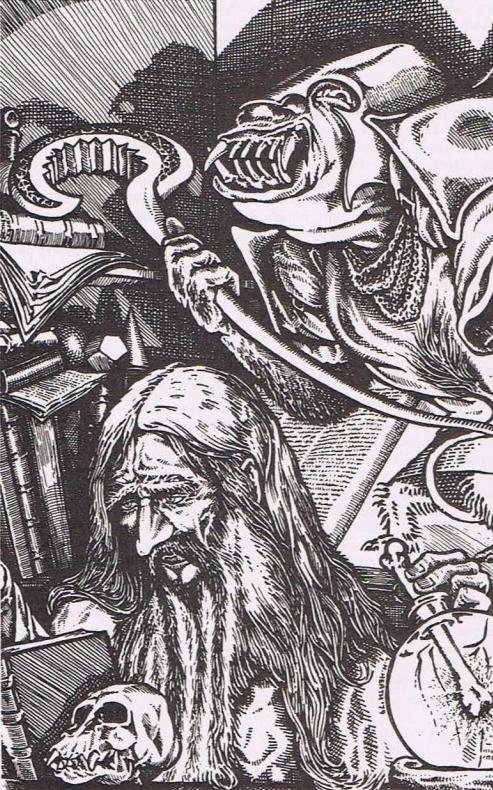
Chapter Seven: Playing Rules
Rules! Oh, thank the merciful heavens! I'll whomp up some belief for you immediately God, I know you only do favors for us when you're sure we'll pay you back.
The game dives straight into character generation, so in order to illustrate it I'll be making a Fantasy Wargaming character to play. Fortunately I have an image just chilling on my hard drive I've been meaning to make into a character for a while now.
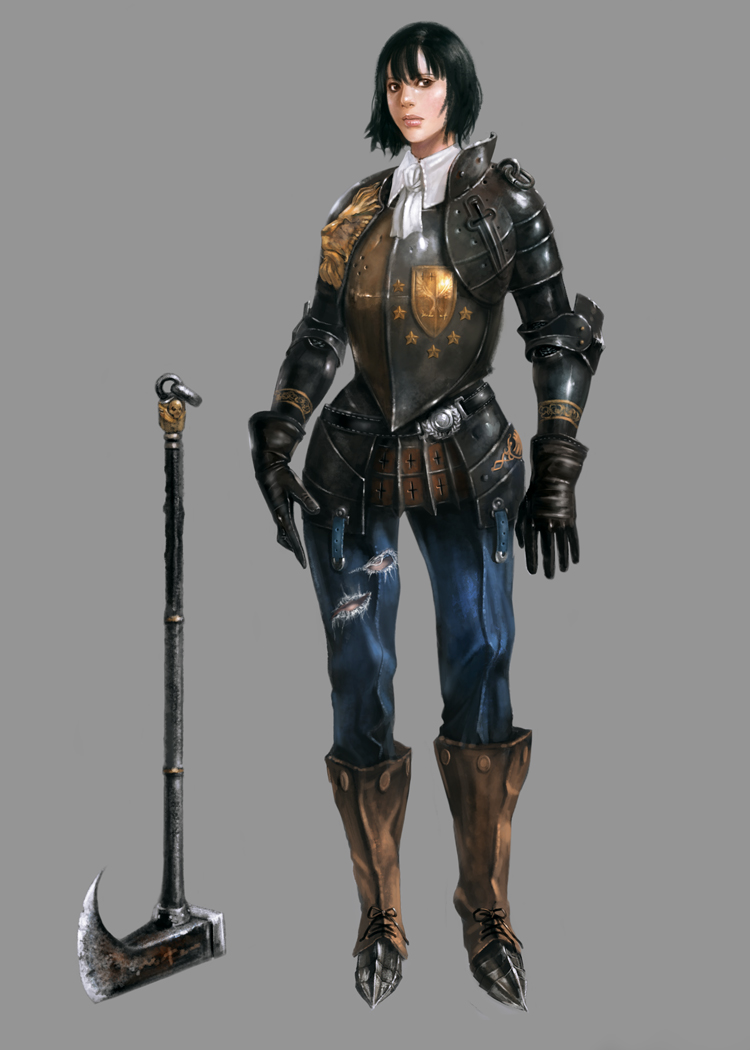
There we go. Doesn't she look like she can take care of business? I plan on basing her off of Joan of Arc, only English instead of French and hopefully not burned at the stake, maybe later we can teach her a spell to put out fires or something. I know that a starting character is unable to begin play as an army leading, divine power packing instrument of royal power, but it'll give me a goal to work towards. Also all stats are random, including some which determine personality, so our image of young Joan of Sussex may change once we roll up her faith score--if I get high, she'll be an instrument of divine will, but if I roll low she'll be a coniving manipulative power hungry killer, and that's good too in it's own way.
Also I like her... what do you call that? Collar? Cravat? Whatever, she's clearly a fantasy hero.
Anyway, characters have eleven primary statistics, which are determined by a roll of 3d6. Because I want Joan to be great at everything, I am going to whine at the GM to let me roll 4d6 drop the lowest. And because I am the GM, I'm going to let me do this. As a result, I get the following stats.
pre:
Physical
Physique: 13 Agility: 15 Endurance: 6
Emotional
Greed: 8 Selfishness: 16 Lust: 15 Bravery: 13
Mental
Charisma: 11 Intelligence:10 Faith: 16 Social Class: 5
You may note the stats Greed, Selfishness, and Lust. Lower on these stats is better, because you don't want your hero to be a greedy selfish lustful bastard. What's the difference between Selfishness and Greed? Well, in Joan's case, 8 points. If you think the book is helpful in spelling out the difference you haven't been paying attention at all. It hardly matters, all three stats only exist to let the GM jerk you around like the toy puppet you are, and are only used for ad hoc encounters.
 Next we apply the Astrological sign Joan was born under. Joan of Arc was born on January 6, and so was Joan of Sussex, dammit--which makes her a capricorn, the astrological symbol of soverignity. This applies the changes from the following chart.
Next we apply the Astrological sign Joan was born under. Joan of Arc was born on January 6, and so was Joan of Sussex, dammit--which makes her a capricorn, the astrological symbol of soverignity. This applies the changes from the following chart.
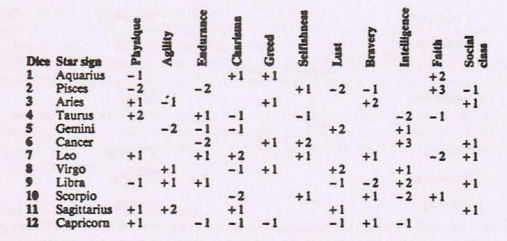
And finally, we roll 2d6, subtract seven, and get that many bonus points to throw around. Yes, you can get negative bonus points, this means you have to subtract points from your stats. Yes, this means that more than half of all characters can't bump up a stat a point or two to help them meet a concept. Negative emotional stats are reversed... spend a bonus point to lower them. I roll a 4 on two dice, and have to subtract a point from three different stats. I drop one out of Agility because I have plenty, one out of Social Class because it's hardly any worse, and put one into selfishness because again, can't get much worse. I guess wanting to lead armies to conquor nearby nations is pretty selfish.
pre:
Physical
Physique: 14 Agility: 14 Endurance: 5
Emotional
Greed: 7 Selfishness: 17 Lust: 14 Bravery: 14
Mental
Charisma: 10 Intelligence: 9 Faith: 16 Social Class: 4
quote:
Players wishing to play a female character must unfortunately take the penalties of a patriarchal society. Make the following adjustments to diced characteristics: physique and endurance -3, charisma -2, social class -3, bravery -2, greed / selfishness / lust -3. They will be excluded from combat, from all parts of the Church save the nunnery, and expected in most cases to adopt a domestic position as wife, housekeeper, and servant. These factors are invariable.
That's right. If you're playing a female character in Fantasy Wargaming, you don't get to participate in combat . It is against the rules for you to fight the French. In Fantasy Wargaming , a woman's place is pregnant in the kitchen, but maybe she can do something else as long as it doesn't involve fighting anything.
Before I forget, I need to make an adjustment to the character portrait.
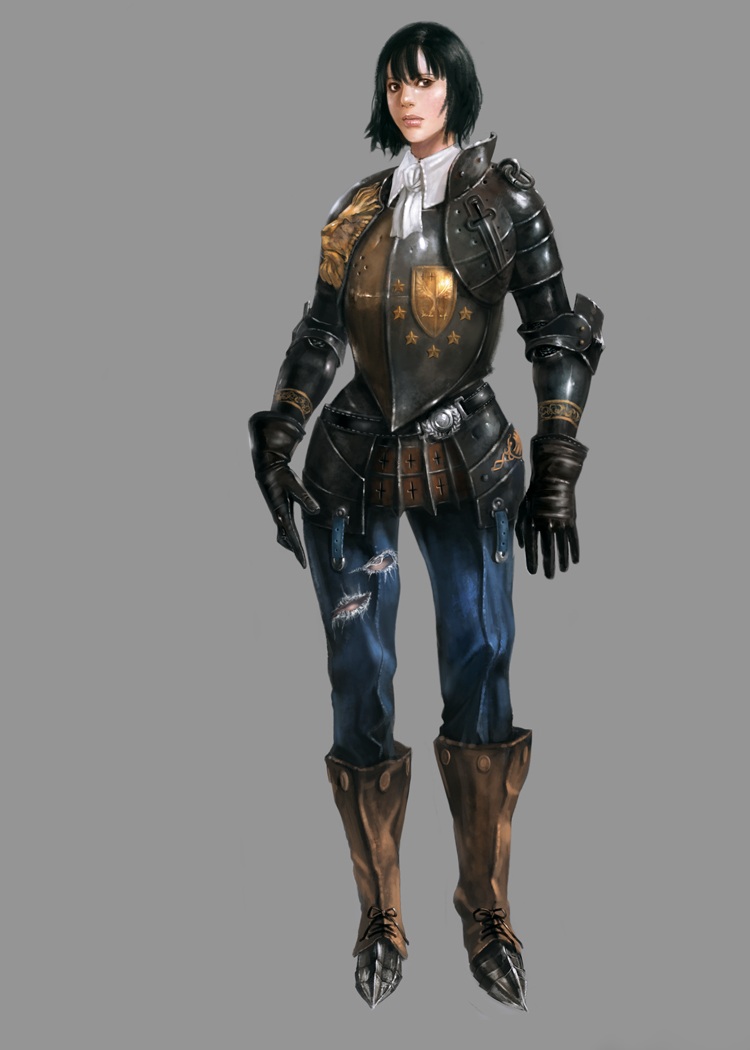
Much better.
Everything about this is offensive. Even the 'bonuses' of the penalties to the negative stats are offensive. Way back at the start of the book it suggested playing a, "brazen harlot," and now we see that women in this setting just arn't very lustful. They're pretending to feel human emotions to steal your money, maybe, but they just don't feel as much desire as men do. Or have courage. -4 str, that's a given. Also the rigors of childbirth are so hard because women are crazy frail. Also no one listens to them. And they get a three step penalty to social class, even though later in the book it clearly states that a woman holding the same social rank as a male has a social class only one lower, so the discrimination isn't even evenly applied.
Fortunately, it turns out that the minimum that Social Class can be for a starting character is 10, so I guess she's doesn't start play as a status 1 quadruple slave . I don't know if that's a thing, but here's the chart.
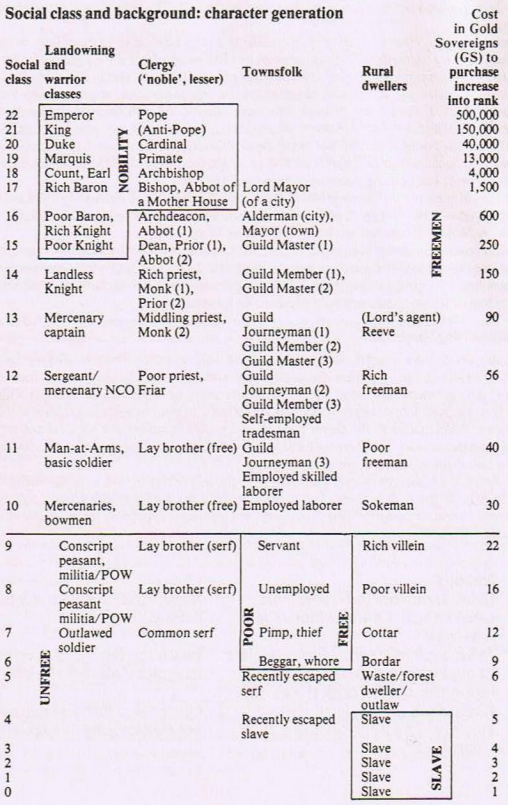
I'm going to take a brief break to storm up and down my apartment grumbling loudly, so here are Joan of Sussex's final stats.
pre:
Physical
Physique: 11 Agility: 14 Endurance: 2
Emotional
Greed: 4 Selfishness: 14 Lust: 11 Bravery: 12
Mental
Charisma: 8 Intelligence: 9 Faith: 16 Social Class: 1(actually 10)
Chapter 7 (again!)
Original SA post
Right! There was a brief break when shifting in my teeth caused one to shatter like porcelain. But I'm back now, high on codine and will be until I get the roots drilled out in a major hospital, as the dental clinic was too small for the invasive work they need to do.
Fantasy Wargaming: The Highest Level of All
Chapter Seven Some More: More terrible rules in no particular order.
So we left off after figuring out Joan of Sussex's stats, which started out pretty good before they were assessed a -22 penalty for the unforgivable crime of describing a character with a vagina. The page with the sexism is facing the sample character sheet, included for your enjoyment.
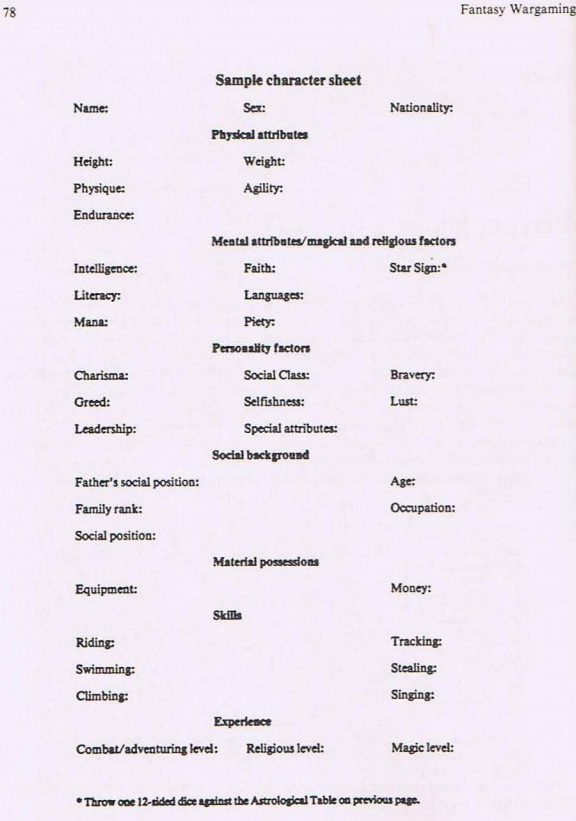
Why is it indented to the right? For the same reason that it's got the same size area for equipment as riding (which will be yes, no, or well), for the same reason there's instructions on atrological sign but nothing else, for the same reason it's crazy ugly even for this book. Someone banged it out in two minutes and no one did any playtesting.
Stats and derrived stats are all in a big pile--I'm just assuming you roll for the eleven stats on the astrological table, but I might be wrong, but I'll describe them in the order the book does.
Assume that unless I say the mechanical effect something has, the book does not describe any mechanical effect. Remember this comes from the time of OD&D, when your stats were not there to define for you what your character could do, but rather were guidelines for the GM to hand down fiat with. A good time, a simpler time, when players knew their place and were not allowed on certain golf courses.
Physical attributes
Height and weight are derived from Physique and Endurance, respectively. They are noted as 'invariable' which means if you want to play a portly friar, fuck you. Joan's skewed stats leave her at 5'6", which is above average for a woman in Fantasy Wargaming but pretty short by real world standards, and a weight of 70 pounds, which sounds dangerously unhealthy to me. Maybe she can get work as a bikini model. Let's update her portrait.

Does she look think enough to you?
The stats of a character naturally go up in play, so I guess all PCs naturally grow towards the ideal height of 6' 3", the height of a half man, half giant with a mighty physique of 20. What's that, you say? There are plenty of tall people who are not strong? There are studies done showing that people in medieval europe were about the same height as modern europeans? These questions are never addressed.
Phsyique is for carrying shit and hitting shit. Agility is for moving gracefully and hitting shit. Endurance is for not dying of dysantry. Endurance points are lost during adventures, but return during rest to the maximum, which means I guess they're also your hit points. Joan is
proper
fucked with her Endurance of 2 then, thank god she's got all that armor and that she can't participate in combat. We must protect this wilting lily!
mental attributes/magical and religious factors
Intelligence is intelligence. I guess it's there so your DM can say, 'you're too dumb to think of that plan' because it's not good for much else. Faith is your ability to cast spells, and has nothing to do with faith in your chosen object of worship. Star Sigh, we've seen. Literacy is a bit odd, I'll skip it and languages and cover them in the skills section, where they should have been covered in the first place. Mana is a measure of your magical energy, has to be 'accumulated' and is limited by level--basically, it starts at 0, but the book doesn't say here in chargen because the book is shit. And Piety is a measure of how much your chosen god/devil/big norse dude loves you. No rules for what it should start at, and even though choosing a religion is entirely your choice, you don't get to choose athiest/heratic and leave it blank.
Personality factors
Charisma, how much people like you. Women are unpopular, of course. Social Class is just that--and I appologize. Last update I said that it had a minimum of 10, but that was me misreading the text. The actual minimum is 0. Joan of Sussex is indeed a quadruple slave, and I have updated her character portrait to reflect this fact.

Eeeeeh....

Anyway, Social Class is 'the most important characteristic of all,' as in adventurous fantasy, what defines a man is not his skill with a blade, or his mastery of deep mysteries, or his piety before god, but how many people he's legally allowed to urinate upon and how many knobs he may have on his coronet.
Bravery, Greed, Selfishness, and Lust define the personality of your character, something other, better RPGs let you do yourself. They exist soley to let your DM jerk you arround, or in the case of Bravery, so you regularly miss combat turns. We will investigate them in detail later.
Finally, Leadership is a weighted average.
pre:
Leadership
(3xcharisma) + physique + intelligence + bravery + (4 x social class)
10
Now, your social rank automatically goes up by one at warrior levels 2, 5, 8, and 11, cleric levels 3, 5, 6, 9, and 11, and magic levels 4, 8, and 11. Alternatively, if you accumulate enough gold, you can buy your stats up directly as appropriate for the social class table, which I reprint here from my last post.

Did I not mention that there are only three classes, but all characters are all three classes? There are only three classes, but all characters are all three classes. Joan is a Warrior 0 / Religious Figure 0 / Magic User 0. This isn't explained for some time, but my obsessive need to present this crap as if it made any sense at all forces me to deviate from the text constantly.
Material Posessions
This section is four sentences long, and basically says 'we will totally cover material possession later.' Later means five pages.
Skills
This is after the bogey section, but I want to do them now.
Basically, you have a set chance to be 'skilled' at something, based on your stats and social class. If you are skilled at something, then you can do it I guess. Again, these are all just guidelines for your DM to hand down fiat decisions with.
The chance of getting any specific skill is calculated differently from how you get any other skill, because consistancy is for communists. We still cared about the communists in 1981, right?
Add together every point of intelligence or social class above 12, subtract every point below 8, multiply by ten, add ten for being a mage, 10 for being a cleric, subtract 10 for being a warrior. This is your chance of being literate. Remember, literally everyone is a warrior and a mage and a cleric, so I guess you just add a flat ten. Including her flat ten bonus, Joan of Sussex has a negative seventy percent chance of being literate. On 1d100, I rolled a 51. She can not read or write. Had I rolled a negative seventy four, she would be able to read or write any language she knew.
Half of your chance to be literate is your Languages skill, which is your chance to know any specific language you encounter in your adventures. This means that Joan of Sussex has a negative thirty five percent chance to speak English, which goes a long way to explaining why she's a quadruple slave. Assuming that we're ment to assume you automatically speak your native tongue (which is fair, this doesn't seem like a glaring omission or thunderously bad rules, just a minor oversight) it still means that any Englishman enjoys an equal chance to understand Latin, Welsh, French, Spanish, Chineese, Iriquos, Ebonics, or Klingon.
Nobility, Warriors with an agility of 10, clergy with an agility of 14, and freemen with an agility of 14 can ride well. Other freemen have a chance of double their agility plus their social class to be able to ride, but not well. Unfree, poor free, and slaves all have a chance of half their agility to be able to ride, and they can't ride well unless their agility is a natural 18. Joan's is only a 14, so she has a 7% chance of riding. I roll a 91. She can not ride.
Your chance of swimming is five times your agility, but if you have an agility of 14 you automatically swim well. Joan therefore swims well. Your chance of climbing is only your agility, but again a 14 means you automatically climb well. Joan therefore climbs well.
Tracking is restricted to nobility and rural dwellers. Were Joan one of these, she'd enjoy a chance of twice her intelligence plus agility to know how to track, but she's not, so damn.
Stealing is all theif skills--having this skill means you can try any thief crap like pick pockets and moving silently and shit. All poor free and slaves with an agility over 10 are thieves, which means Joan is a thief. Unfree peasants need an agility of 14 to be a thief. Freemen, nobles, and clergy can not be thieves.
All clergy can sing. 66% of nobility can sing. 50% of slaves can sing. 33% of other people can sing. If you can sing, if your charisma is at least 14 you sing well. I roll a 6--Joan can sing, but not well. Men sing much more beautifully than women do, because men do everything better than women do.
"Bogey table"
This is sort of a advantage and disadvantage table rolled into one. You randomly get to roll one, two or three times on this table using a d100, but about a third of the table is blank--get nothing, and you get no bogey. This makes me wonder why you get a random number of rolls on it, but not for long--the answer is the same as the answer to any question about mechanics, because they threw this turd together in one pass and never playtested anything.
Some of them are good, some of them are bad. Some of them modify your stats, like Limp that give -1 to agility and slows you, or Gift of Sleep which lets you sleep at any time and gives you a +1 to endurance. Some refer to rules that don't exist, like Resistance to fatigue, which doubles the amount of time before you become exhausted. Some are just descriptive, like Sexual charm, which makes you sexually irresistable but includes no charisma bonuses. Many are vaguely offensive, like Jewish, you will be persecuted and shunned by all right-minded Christians. Whatever, let's roll three up for Joan.
 64 Keen Smell; 10% chance of smelling concealed animals, etc., within 30ft. Ignore illusions.
64 Keen Smell; 10% chance of smelling concealed animals, etc., within 30ft. Ignore illusions.
Those damn nasal illusions have killed more of my characters than I care to remember. It's good to have a
 36 Bisexuality; Attraction to both sexes.
36 Bisexuality; Attraction to both sexes.
I'm not sure I'm comfortable having this decision made for me by a chart. Also, that's a class 2 sin, constantly. We'll go into more detail later, but for now, just know that it's slightly worse than peeing on a bishop you just set on fire while screaming, "God can go fuck a duck!"
 98 Lycanthropy; Voluntary change to wolf, bear, or dog once a month for 12 hours.
98 Lycanthropy; Voluntary change to wolf, bear, or dog once a month for 12 hours.
Wait, what?
pre:
Name: Joan of Sussex Sex: Pitiful Human Female Nationality: English
Physical attributes
Height: 5'6" Weight: 70 Lbs
Physique: 11 Agility: 14
Endurance: 2
Mental attributes/magical and religious factors
Intelligence: 9 Faith: 14 Star Sign: Capricorn
Literacy: No Languages: -35%
Mana: 0? Piety: ???????
Personality factors
Charisma: 9 Social Class: 1 Bravery : 12
Greed: 4 Selfishness: 14 Lust: 11
Leadership: 6 Special Attributes: Bisexual, Keen smell, Lycanthropy
Skills
Riding: No Tracking: No
Swimming: Yes, well Stealing: Yes, well
Climbing: Yes, well Singing: Yes
Experience
Combat/adventuring level: 0 Religious level: 0 Magic level: 0

A hairy, snarling beast, but only once a month. Women , amirite?

Chapter 7 Doubleplus
Original SA post Fantasy Wargaming: The Highest Level of AllMore of Chapter Seven: The last of chargen
We'll be through here shortly, I'm almost done.
All that's left is to figure out Joan of Sussex's social position and possessions. You do not choose your social position on the social classes chart. Instead, you choose how you're related to your father, and consult the chart for his social position. I suppose this is because you are not a freeman or a noble or a craftsman or whatever, but rather an adventurer--but that clashes with the fact that your skills are determined by whether you're a freeman or a noble or--well, whatever.

You get to choose your own relation to your father--if you want a more important dad, you can accept a less important role in the party, which is cool, and pretty much the only customization you get. Also, if you roll a 18 on Social Class, and are an Ares, Leo, Cancer, Libra, or Sagitarius, you can be the bastard son of the Pope, which is a damn fine character concept by anyone's measure.
Your father is one to three social ranks above you, and how it shakes out differs very slight between nobility, freemen, clergy, and the like. You can't have a clerical father only one social step above you, because all clerical rugrats are bastards, for example. For nobility, a female heir is two social ranks down while a male heir is only one, while for freemen all heirs are one step down, and for the unfree it doesn't matter if you're an heir or not.
Long and short of it is, the difference between a son and a daughter is only one social class rank at most, and often they share the same social class.
Remember how women get a -3 to social class? Even though in practice the average difference is going to be about one half a rank? One of the downsides of living in a patriarchal society is getting docked six times the average difference in social class because fuck women, that's why. Although it doesn't make much difference for Joan of Sussex, I suppose... she's a quadruple slave instead of a more reasonable slave and a half, but she's still hauling sacks of poo for her owner either way. As a female slave she is one social rank down from her father, who was merely a triple slave and as such a fine and productive member of the slave society.
Finally, starting income. She gets one half the cost of reaching her social rank as starting income. This fraction drops as the social rank goes up, so a rank ten gets one fourth their rank up cost--it's all super arbitrary. Long and the short of it is, this qualifies her to start play with a single shiny Gold Sovereign! This is worth five silver marks, or ten ducats, or twenty florins, or forty shillings, or two hundred groats, or one thousand pennies, or five thousand copper farthings. After all, nothing says verisimilitude like obsessive bookkeeping.
If I say Liesmith's name backwards three times, will he appear in this thread and tell us if those exchange rates are accurate, and if so when and where they were in use? Worth a shot, I suppose! Htimseil, Htimseil, Htimseil.
What can we spend her single shiny gold coin on?
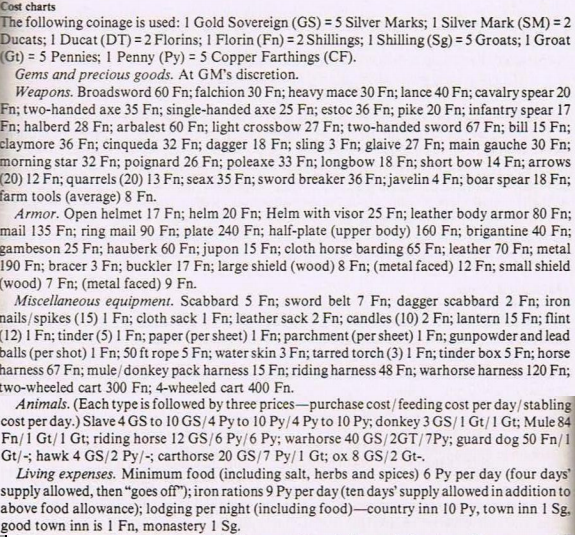
These are the worst equipment tables I have ever seen . Also, there are guns. Anyway, she can't afford anything and she can't use weapons and armor anyway, so I'll just let her keep her coin and start saving up to buying her social class up to a dizzying triple slave , which is like buying your own freedom but less impressive.
Role-Playing Rules
Luck
Every check involves two rolls, a percentile check and a luck roll. This is to make doing things as tedious as possible. Whenever the rules refer to luck, roll a d6. 1=-2, 2=-1, 3=0, 4=0, 5=1, and 6=2.
Leadership Factor
Remember how we calculated Joan's Leadership of 6 earlier? It was a weighted average, with importance placed on Charisma and Social Rank. Well, the in game effect is as follows--whoever has the highest leadership in the party is the party leader, and decides what the party does.
Honestly, I'm not so sure what everyone else is doing there.
Challenging the leader
Maybe the leader orders you to do something you don't want to do. Well, if your leadership is 8 less than theirs, hard shit. They are party leader and fuck you, do what they say forever.
If you want to be the leader and don't have the highest leadership, you have the option of beating the shit out of the boss. This is to prevent intra-party conflict by setting clear guidelines for when you're allowed to murder your fellow party members. You can also vote on who's the party leader--each person gets one vote for each point of leadership they have. Again, if your leadership is low you have no say in your own life and go through the adventures being told what your character does.
Questioning the leader
Again, if your leadership is 8 less than theirs, you are a slave and are expected to act as such. If you initate a question, each side gets fourty seconds to make their case, then a vote is held--again, one point per leadership point. In game, this takes ten minutes. I hope your leader didn't order you to escape from orcs by diving off a cliff! If so, they get ten minutes of pounding on you with swords while you hold a spirited debates on the merits of hurling yourself into the ocean.
If you don't want to question the leader, you have to follow his orders absolutely. Free will is not historically accurate. The only exception to this rule are temptation checks.
Next time, Temptation Checks , for when letting the party leader declare your actions isn't enough!
Chapter 7 Four
Original SA post Fantasy Wargaming: The Highest Level of AllMore Chapter Seven: Letting the GM Play your character
Temptation! Sometimes you and the GM will disagree on what your character will do. You may feel that a certain action is against your charater's personality, while your GM may feel that you should walk into an obvious trap like a slack-jawed moron. When PC and GM disagree on the actions you take, it's time for a temptation check!
First, let's draw up the scene. Joan of Sussex is in a four person adventuring party. The party leader is Chad Brohaus, who is naturally charismatic and has a high social class because his dad owns a
They are in a dungeon hunting bandits. A side door opens up and a buxom wench propositions Joan, then closes the door. Joan's player says this could not more obviously be a trap, and she doesn't want to sleep with a stranger she met literally eight seconds ago. The team leader agrees, saying this is stupid. The GM disagrees, saying that Joan is a, "total slut," and would, "totally go for it."
Before the check is made, everyone in the party who is aware of the temptation gets to weigh in. Chad Brohaus repeats his order--they're in the dungeon to slay bandits, not fall for stupid temptations. Ottoman Davenport says that God would be angry if Joan gives in to homosexuality. Lord Magus Thunderfist says that this game is stupid, and if Joan doesn't get in there and, "Slap some titties together," he swears he's going to blast her with lightning.
Joan has no say in this, of course. Down with player agency!
Finally, some numbers are assigned. A luck die is rolled, and comes up 2... that's -1 for Joan, which is good in this particular case. (One of the random traits you can get is luck. Lucky people add one to luck rolls, which means they're tempted more often because system consistency is another thing Fantasy Wargaming fails at) The temptation value of the temptation is assigned by considering what kind of person it would tempt... if an average person would be tempted, then it has a value of 10, while a value of 4 would tempt pretty much anyone, and a value of 16 would only tempt the truly obsessed. The GM rules this woman has a temptation value of 7, because she's so buxom. Then we define the visible danger--ranging from 5 (no visible danger) to 20 (Thor, god of Thunder, is standing over the woman vowing to slay anyone who sets a hand on her). Because there is no visible danger, and the buxom wench is unable to participate in combat, the danger is a 5. Joan argues that it's obvious there are going to be bandits in that room who will kill her, but the GM points out that she can't see them and so they don't count.
You may have noticed that these numbers are all over the place. This is because they are inversions of the personality traits, some of which are good to have high and some of which are good to have low.
Finally, values are assigned to the opinions of Joan's companions. The leader's orders are always (-2). Normally Joan with a leadership of 6 would be unable to even question the orders of Chad Brohaus and his leadership of 15, but too bad. Other people's arguments range from (-4) to (4). The GM says that being threatened with eternal damnation is worth (-3), and that while Thunderfist's threats were passionate, they lacked any weight because clearly he can't throw lightning, so they're only a (+2).
Finally, everything is added together.
pre:
Luck + Lust - Temptation + Bravery - Danger + Chad + Ottoman + Thunderfist -1 + 11 - 7 + 12 - 5 + (-2) + (-3) + 2 total = 7
Once we have this value, we consult a chart, and find out that because Joan is so brave, she has literally a one percent chance of rejecting fun sexy times with the wench. She has a 31 percent chance of diving in so readily that she temporarily becomes a GMPC. It's almost worse if she gets the 60% chance of accepting without losing control--then she has to role-play the way the GM dictates. Let's hope those bandits before the door shank her before she gets to participate in non-consensual erotic role-play.
The remaining eight percent is a chance that she'll accept if 'offered more'. Ten percent more, specifically. Let's.... let's not speculate.
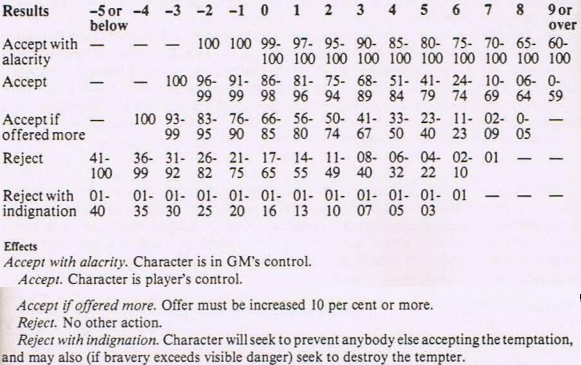
Not only is this system a long excuse for the GM to strip control of the character from the player, not only is it stupidly complex and meandering and dull, the fact that cowardly characters have more control over their own actions than brave ones just blows my mind. Of course, this is only out of combat... cowardly characters regularly get their turn skipped when the real action starts.
Chapter 7 Sexism
Original SA post Fantasy Wargaming: The Highest Level of AllAlright so the rest of the book is all chapter 7, sue me.
I think I passed this by earlier... the section that temptation and leadership is under is titled, "Role-playing rules."
Anyway. Most of this section is bad and dull both, soooo... fast forward time.
Experience level
A character has three classes. They gain experience in each class by completing appropriate goals--by completing combats, by solving problems with magic, or by being religious I guess. Every 1000 exp gives you a level in that class. Starting characters are Warrior 0 / Wizard 0 / Religious Figure 0.
When you gain a level, two of your stats go up (or for sins, down) by one rank, which is kind of cool. As time goes by, you grow stronger, smarter, faster, bla bla bla.
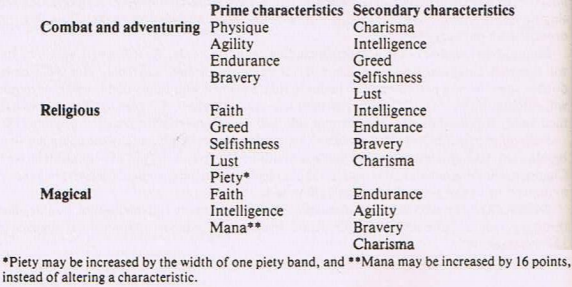
Because you choose one primary and one secondary to improve, and because you can't choose two primaries, a fighter can't improve two physical stats, and a mage can't improve both intelligence and faith. Why? Fuck you, that's why.
Also the shit about mana going up by 16 contradicts the rules on mana given later in the magic chapter. Also improving piety by a piety band is goddamn retarded, given that it's a measure of how you've been behaving.
Persuasion
Persuasion uses the same table as temptation, only the calculation is just Luck + Leadership - Their Leadership + Modifiers.
Temporary handicaps
I'm just gonna quote this section.
quote:
For added realism, the GM should throw at the start of the game day for each character, with two six-dice. A score of 12 will bring any one of the following minor irritants, as seems most appropriate to the GM; head cold, violent diarrhea, splitting headache, abject melancholy, appalling hangover, post-coital tristesse, stabbing pains (in the arms, legs, trunk or groin) inexplicable tiredness, feelings of rejection or inadequacy, etc. Each will last 2-12 hours (two six-dice), and reduce all luck throws by one.
Magical.
Fatigue
Most of this section is a long, unformatted list of how long various activities will take to fatigue you, and how much and what kind of rest will recover you from being fatigued.
There is no explanation for what fatigue means in this section.
Recovery of Endurance Points
Just some completely arbitrary amounts of time for healing rates. Key takeaway... anyone who wants to take part in adventuring does not heal at all.
Combat and general adventuring experience
Getting combat experience can be earned through combat OR adventuring. It follows the following chart.
pre:
EXP = (Opponent's level x 100) OR (monster value)
own combat level
EXP = (100 - chance of success)
2
Joan of Sussex is attacked by a wolf. She fights it of by turning into a bear and killing it. The wolf's monster value is 9, which is divided by Joan's combat level, 0. Joan gains all of the experience and becomes a level a billion character, with 20s in Physique, Agility, Endurance, Bravery, Charisma, and Intelligence, and 0s in Greed, Selfishness, and Lust. She still can't raise a hand to her natural superior, a male.
Obstacles
This is actually like five or six sections--physical obsticles, locked doors, pickpocketing, smashing stuff, bla bla bla. It all works the same way, with different random modifiers.
They all follow the same basic layout... Stat - Difficulty + Modifiers + Luck, then consult on the table.

Also the modifiers and required stat minimums vary wildly based on what you're trying to do.
This is not an elegant system by any measure.
Next time: These combat rules are basically nonsense.
Combat is a doozy.
Original SA post Fantasy Wargaming: The Highest Level of AllChapter Seven: On and on and on and friggin' on.
It has been a while since I have updated this. I keep trying to summarize the rules for combat to something that explains them well enough, and why they are bad. Unfortunately, this is predicated upon upon me understanding them.
And... I don't. Not even a little. This shit is completely incomprehensible. It flipflops between rules for individual fights and rules for mass combat (complete with miniatures put into formation) with no clear distiction between the two. I never know what it's talking about, I suspect half the rules are hidden in the Chainmail rule book (what with all the references to rules that don't exist, this book reels like a total conversion project rather than a stand-alone game) and the endless friggin' tables. THE TABLES OH GOD THEY'RE EVERYWHERE. And they're all ugly and cryptic and stupid oh god!
The good thing (hah!) about Fantasy Wargaming is that it is a fairly rules light system. If you look over what we've covered so far and sort of squint so the misogyny, the class warfare, and the poorly thought out advancement rules, you'll see a single table which gives the GM rulings from success to partial success to failure, a sort of odd bell curve to success, and stats that both act as general guidelines for capabilities and behaviors, and still have a significant effect on success rate, even when there's a difference of two or three points. It's ugly and clumsy, but there's some virtue and it runs smoothly and quickly.
That ends in combat.
I hope no one thinks less of me when I decide to simply do a pass through the combat rules, making no effort to reordering things for comprehensibility. They are incomprehensible . I do not comprehend them. I can't help you comprehend them. They are a bottomless mystery.
Group Combat
Who can fight?
Anyone with a weapon, but women. No unarmed combat.
Selecting a warrior and weapons
Honestly, I thought character generation did this. You even bought your weapon with starting money chosen from your social class. But no, a player should choose a 'warrior type' while 'taking special note of the social standing of his character'. Yyyup, apparently equipment bought has nothing to do with anything . Favorite quote of the section:
quote:
Also included in the warrior tables is the "heroic" character, which can only be used [if] the Gaming Master agrees.
That's right, by default the PCs are not heroes. Fuck you, that's why!
Combat
quote:
Combat is based on a simultaneous flurry of blows; however, missile weapons and those with a significantly longer reach are allowed a first strike. Missile weapons can obviously be used repeatedly until the enemy's proximity forces a character into hand-to-hand combat.
I just checked, there are no rules for movement in small-scale combat. Or for archery. Fuck you, that's why.
Combat Sequence
One, check morale. Two, check berserk if you're Norse. Three, people who didn't lose their action in steps one or two (oh, it happens) decide what they're doing silently. They write their action down. Four, missile fire, still pretty sure it's not covered. Five, magic. Finally, combat. First strike going to people who have a significantly longer weapon (as measured in feet) or who have an agility four higher than 'their opponent'.
Let's pretend.
Because I can't use Joan as an example for anything in this section, Chad Brohaus, heir of the
Morale
There's a big ole list of modifiers here for yet another probability table. As always, roll for luck, and apply all these modifiers to the character's bravery score. Apply the modifier for your ascendant astrological sign (christ) or a penalty for an ascendant opposing astrological sign.
Consult the table.
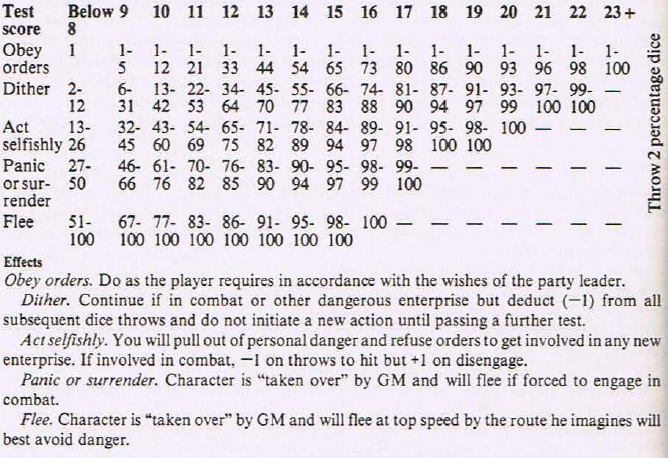
Dither is basically Obey Orders (of course you don't choose your own actions in combat, party leader declares your actions in combat? What about what you wrote down on your paper, you ask? Fuck you, I say!) but with a penalty.
"But Mystic Mongol!" you say. "This chart implies that an average fighting man, with a bravery of 10, fights competantly only twelve percent of the time, fights at all only fourty two percent, and has a flat fourty percent chance of running away crying or throwing down their weapons and surrendering! I have to make this at the start of every combat!?"
Every round , chucklefuck. Also, there are more potential negative modifiers than positive ones. And the only common positive modifier is for having a higher level leader, which you only get if you're the party gimp. So the weakest members of the party are also the bravest, if anyone's brave at all. Also the dither penalty lasts until combat is over. And it affects further morale rolls.
Also remember that if you have an above average bravery, you might get to act in combat more often, but you also constantly fail temptation checks because brave people sell out their friends at the drop of a hat. Hell, even a bravery of 10 makes you almost certain to fail temptation checks if there isn't a goddamn sword pointed at you when you make it.
Fuck you, that's why.
Berserk
Norse players have their own problems. They might go berserk. This chance goes up as time goes on. It's actually pretty hard to go nuts unless you're dumb as a sack of rocks and not wearing any armor or shield. Note that even if you do you don't act before your opponents, so you die because you're not armored or shielded.
Going berserk gives you a -1 to hit and a +3 to damage. Is that -1 a modifier to the table check, or a -1%? I dunno, fuck you. Berserk players are controlled by the Gaming Master, although they don't attack allies.
Combat Procedure
Do you... do you mind if I skip this?
I'll summarize.
Three pages of modifiers, in no particular order.
Parrying, dodging, or disenganging are all instead of attacking. Because all combat is simultanious, you're basically opting out of that combat round.
Parrying, dodging, and disengaging has it's own section of specific modifiers, including the square footage of available space and the class of weapon used on each side.
Nineteen tables. Here are three.
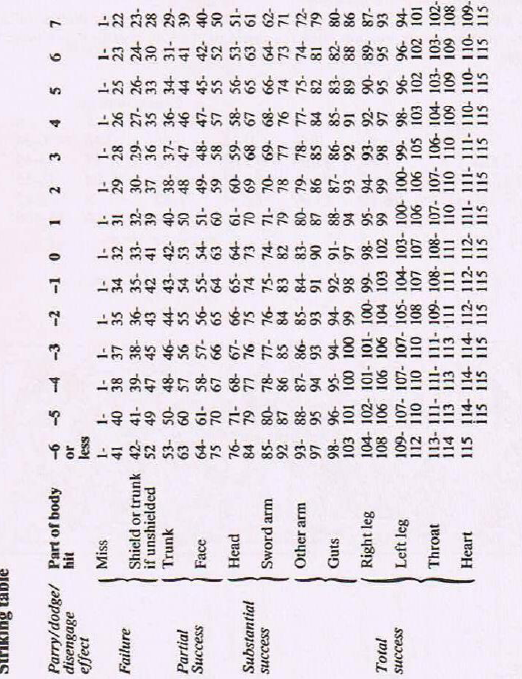
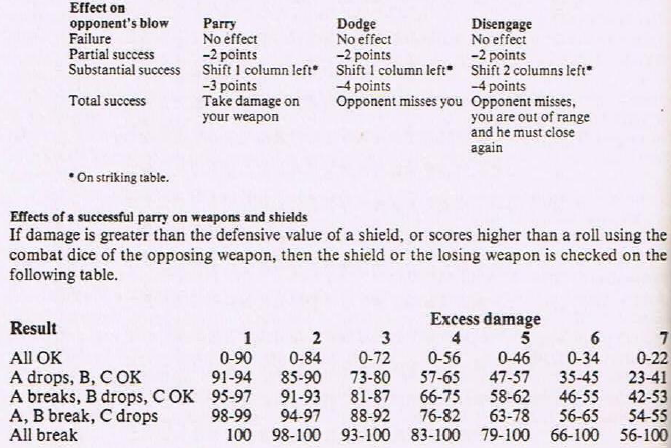
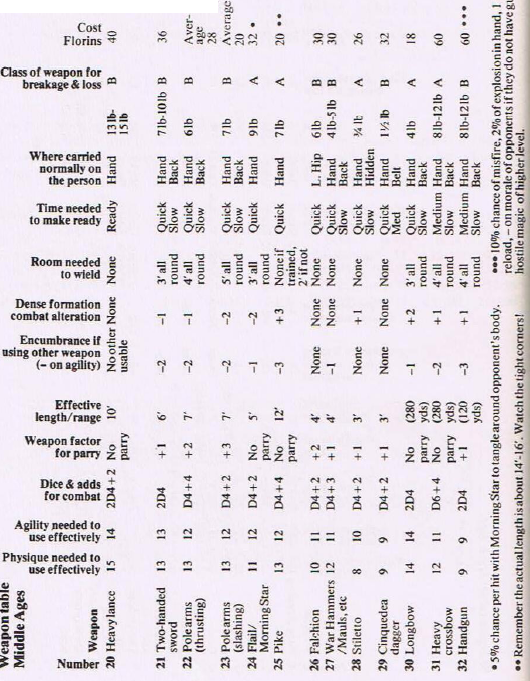
Joan of Sussex has clearly dodged a bullet here. Before combat the system was stupid. Once combat has been introduced, it became completely unplayable. The words in this book mean nothing , are an unplayable mess of absolute trash. It should have never gone to print. It's not ready for playtesting. This is worse than Anima. This is worse than FATAL. You may say that the charts and numbers are smaller, that you can't instakill your opponent by cramming your dick up their butt, but both of those games have things you can do in combat. In Fantasy Wargaming, you write down your action, then you throw your action away and do what you're told, and then you don't because the rules for attacking someone in combat with a sword are incomplete.
Fuck this game.
I am going to flat out skip mass combat rules. Just accept the fact that you're supposed to take the normal combat rules, complete with character statistics, and use them to fight with two armies made up of 25mm scale army men, who stay in warhammer fantasy style formations, and move on.
There is nothing good here.
Next time: Joan of Sussex fails to be a witch!
Combat Charts
Original SA postJalathas posted:
Say I have a pike, and my opponent is more agile but has a dagger. Is there any priority given to these modifiers, or do we just stare each other down for all eternity?
What kind of question is this? Fuck you, buddy!
Actually because you have a pike and he's fast with a dagger I assume you'd first get 'first strike' and attack each other simultaneously before anyone else got to act.
But don't worry! He might have an agility four higher than yours, but his combat agility (agility plus half the difference between his agility and the agility required to use a dagger effectively) might not be four higher than yours! Or maybe it's based off of normal agility. Man, I don't fucking know. These rules are wildly inconsistent , and after the explain how to calculate your combat agility and combat physique, neither term is referred to again.
Combat physique and combat agility are affected by the astrological conditions.
Astrological conditions have not been explained yet, and indeed are not addressed until the section on magic.
Hamiltonian Bicycle posted:
This is amazing.
I kind of want to see all the other tables, just to bask in the lunacy.
Yeah, alright. I've separated them by which subchapter they appear in. Remember this has nothing to do with the contents of said subchapters... for example, the first thing they tell you in group combat is to look up your warrior type according to social class and culture, and that doesn't show up for a while.
Group Combat Tables!
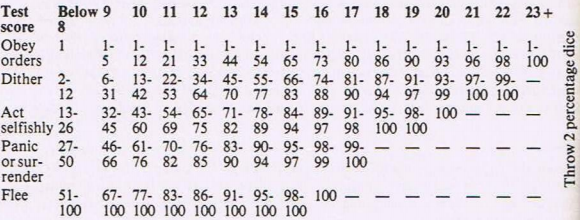
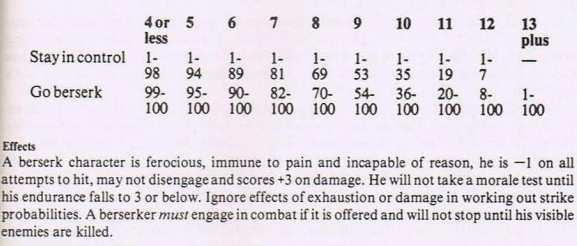
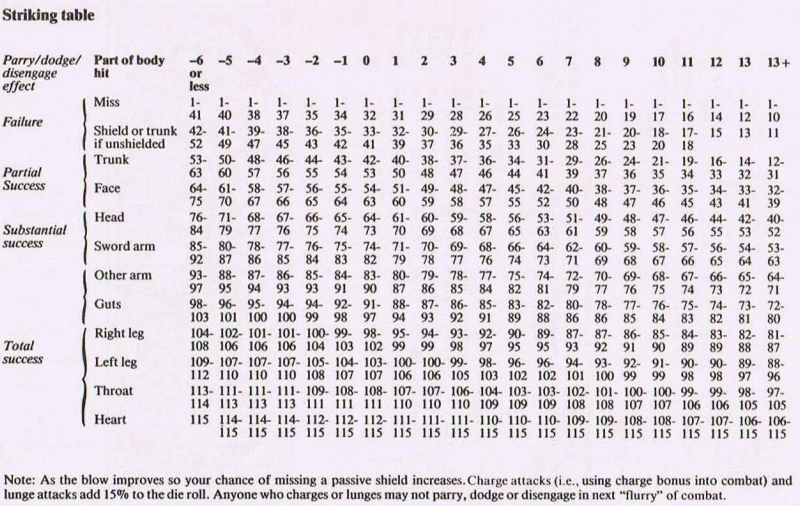
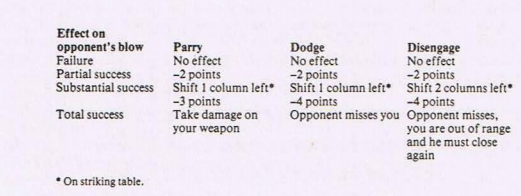
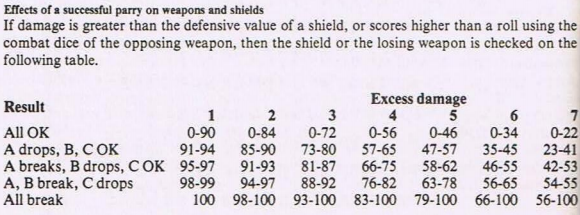
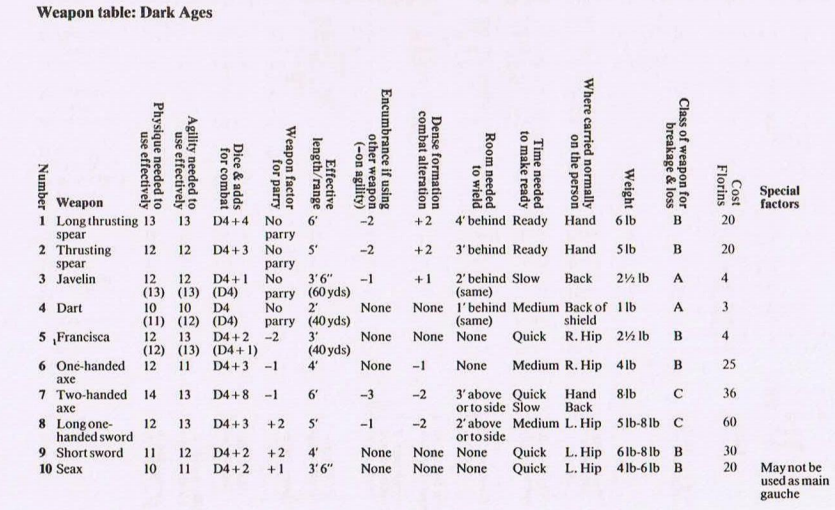
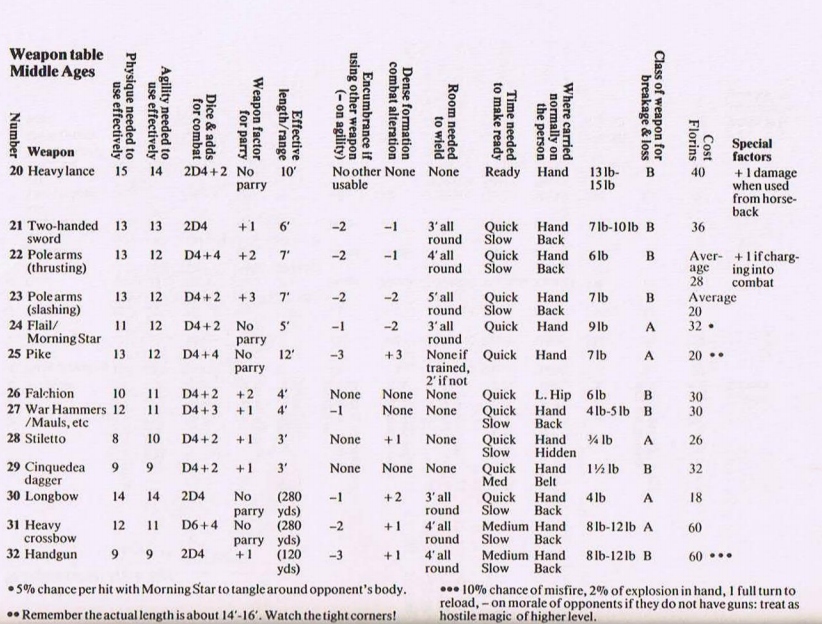
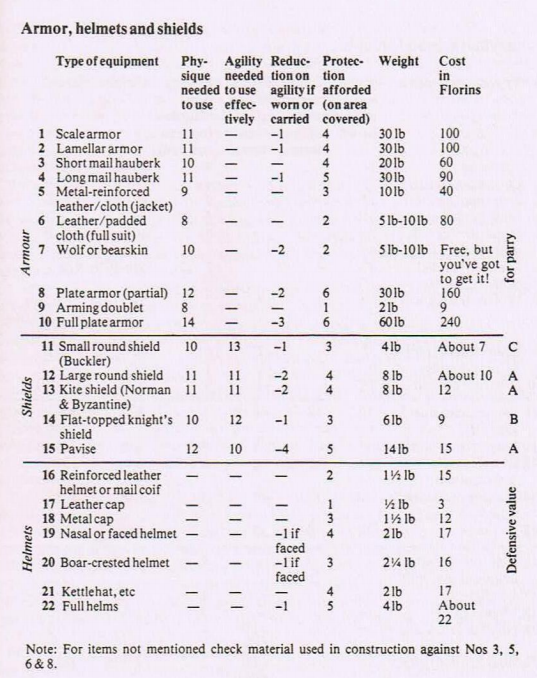
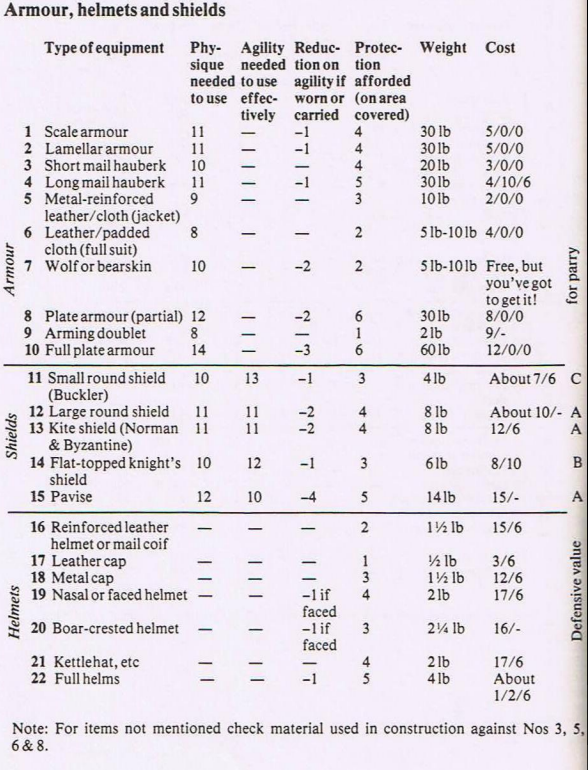
No, those last two tables are not identical. You may be forgiven for thinking they are. I do not know why they both exist.
Large Scale Combat Tables!
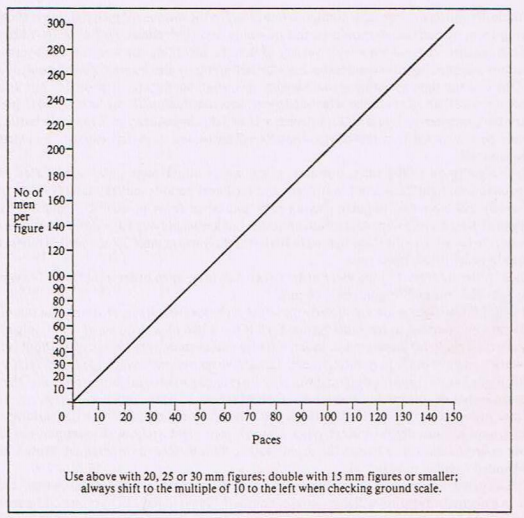
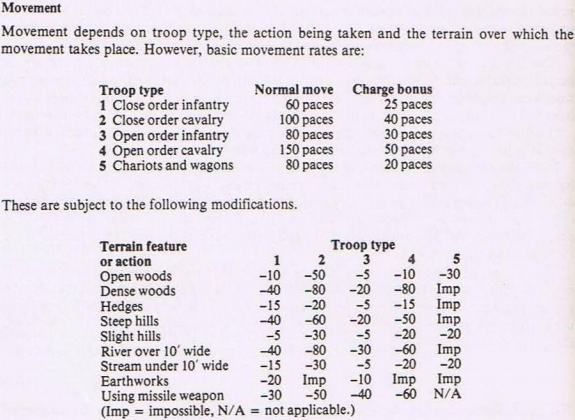
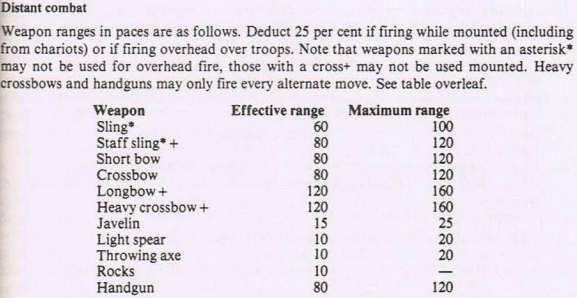
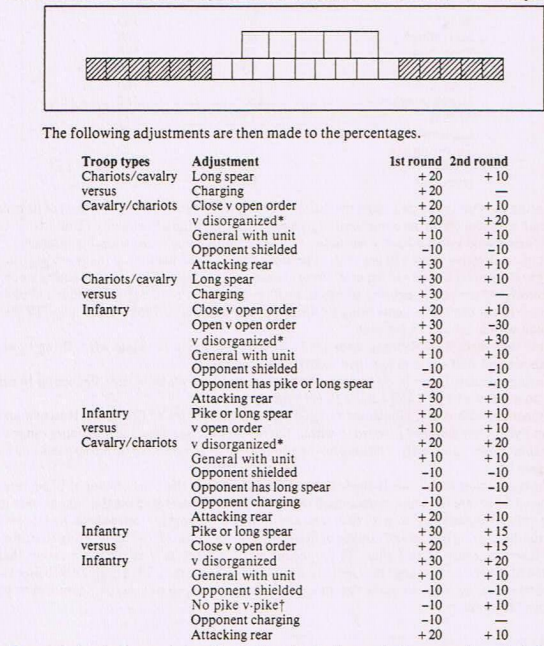
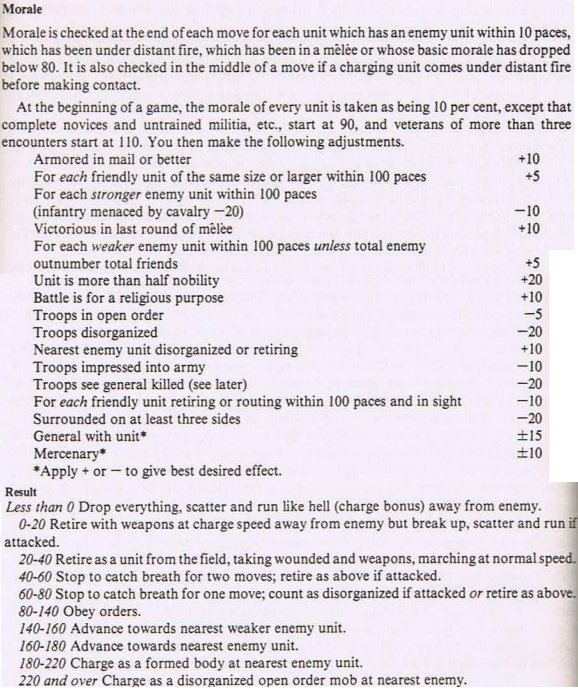
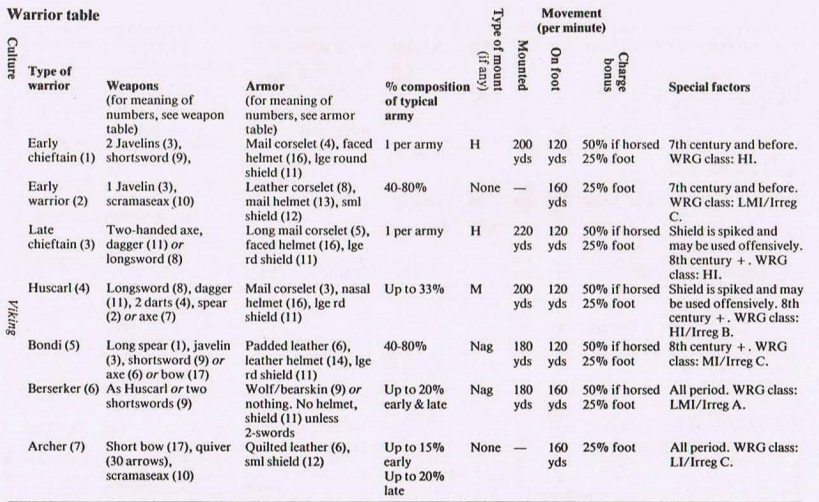
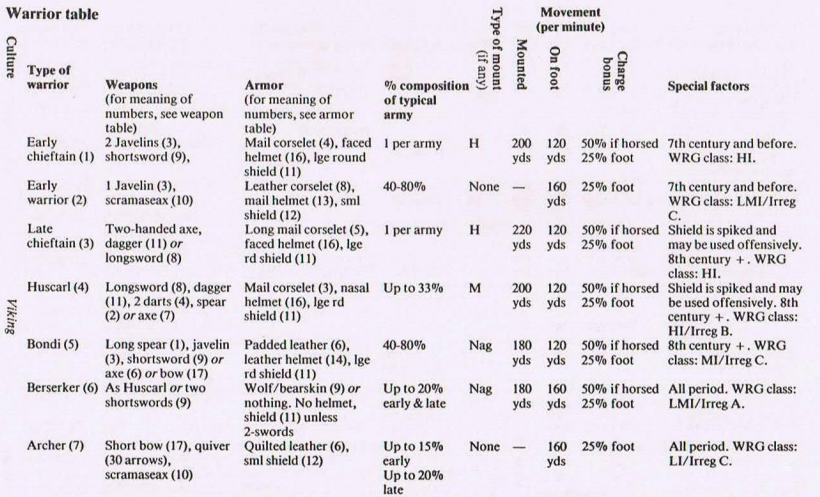
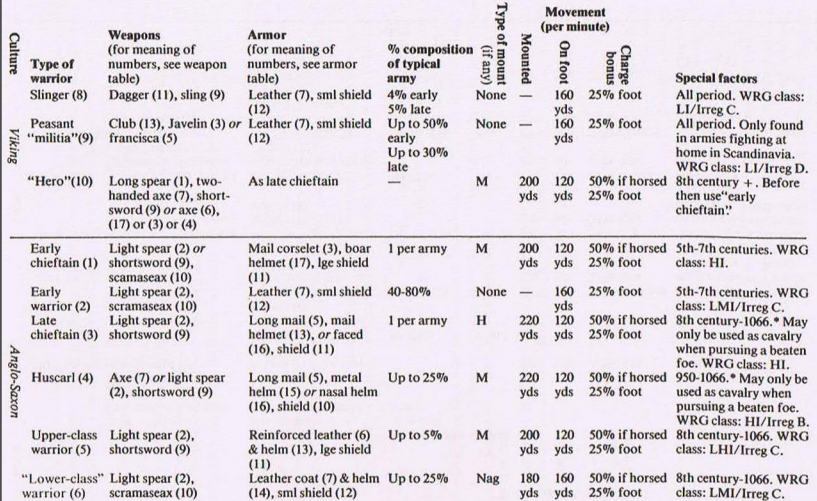
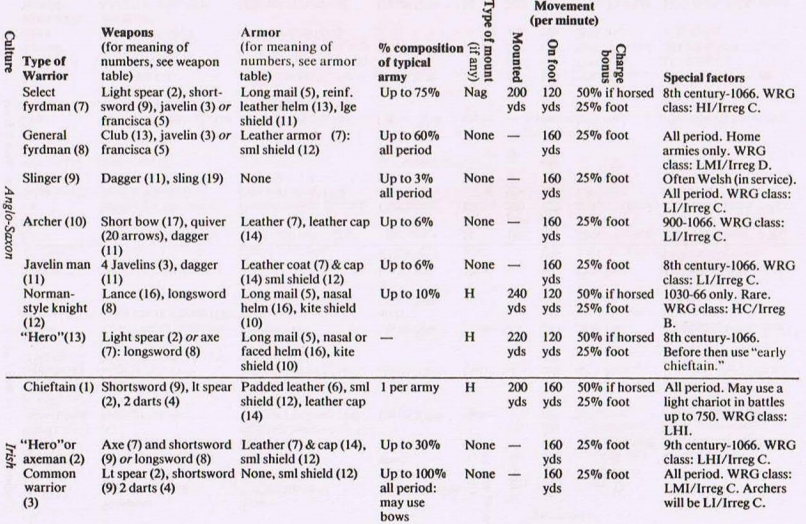
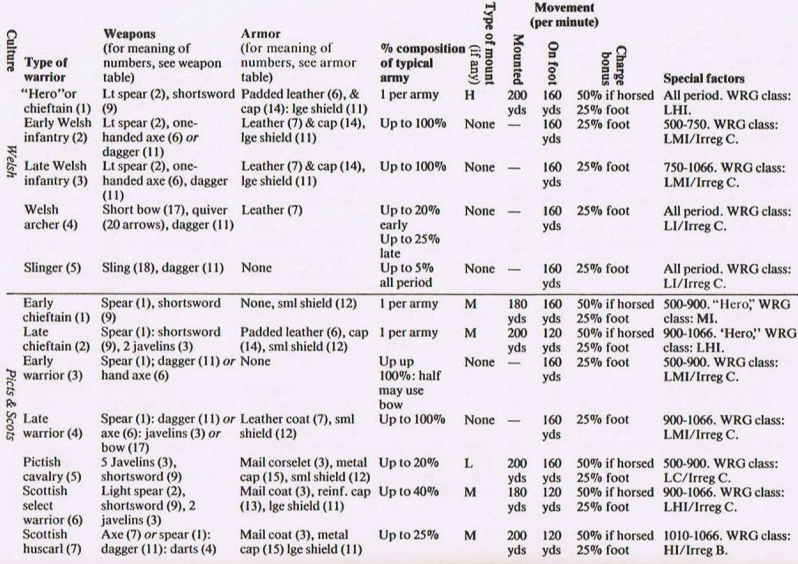
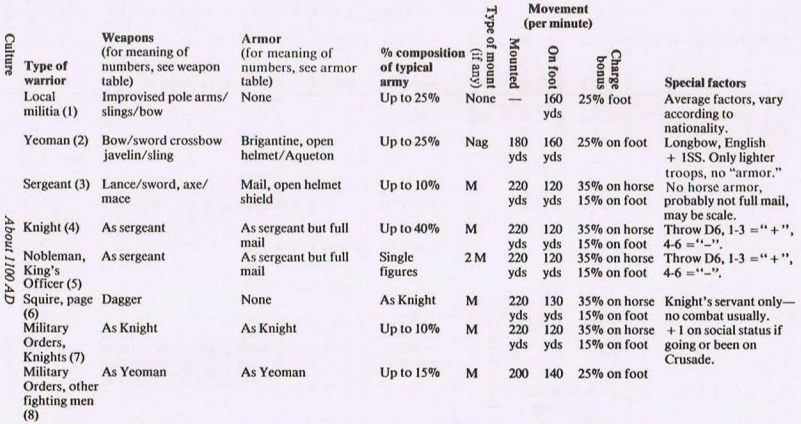
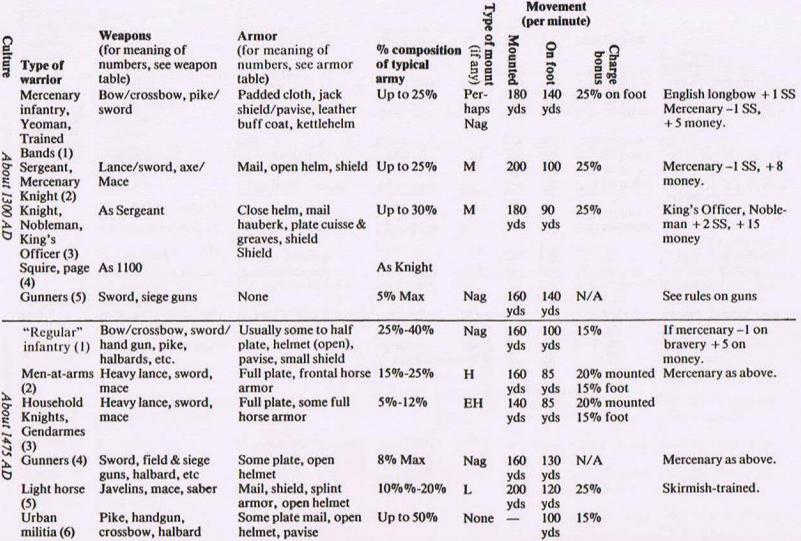
A few weeks ago I flipped my wig over people talking about how great Fantasy Wargaming was as a system over in Grognards.txt. I frothed about it in the thread about people pretending to like versimilitude heavy rules and being in favor of the 'realistic' penalties to being female, and I kicked off a debate about how large a 'realistic' penalty to strength for a woman would be, but that was never what I was angry about. It was the combat rules. It was fat, sweaty nerds pretending to like a game because it has, 'No Gurlz Allowed' written on it. Fuck you shits, you've never played Fantasy Wargaming. It's unplayable. No one's played it, you lying fucks, stop trying to be cool on the goddamn internet by promoting a culture of excusion.
Argh.
Chapter 7 Magic
Original SA post
Your ancient crazy tome magic system is stupid. Let's look at a stupider one instead!
Fantasy Wargaming: The Highest Level of All Them Levels
More Chapter Seven: Black Magic Woman
She can't fight and she's bad at everything but stealing things. She'll never gain a level through adventuring. She's a slave, and presumably owned by Chad Brohaus. And as a woman she can't hold any significant position in government or in the church.
Active Magic Rules
There are two kinds of magic in Fantasy Wargaming. "Passive Magic," also known as, "Magic not appearing in this section," is divination and study of magical influences, including tarot and astrology. Rules for Passive magic are long and stupid, and we'll enjoy them together in time.
Active magic is the act of actively impressing magical energies on something, as opposed to passively observing it. It's a simple process--first, establish a link though the Ethereal plane connecting you, the magic user, with the subject of the magic. This requires a great deal of faith, which is the primary stat for casting magic, not faith in a higher power, unless it is faith in a higher power. Preparation, correspondences, magical items, and luck all play a role. Then you can cast up to three spells (or seven absolute commands) though the link, although the link only lasts a half hour.
Seems simple enough!
Fantasy Wargaming: The Highest Level of All posted:
Yeah, of course it's not simple. Congratulations! You can recognize simple patterns.
We'll need our character.
pre:
Name: Joan of Sussex Sex: Pitiful Human Female Nationality: English
Physical attributes
Height: 5'6" Weight: 70 Lbs
Physique: 11 Agility: 14
Endurance: 2
Mental attributes/magical and religious factors
Intelligence: 9 Faith: 14 Star Sign: Capricorn
Literacy: No Languages: -35%
Mana: 0? Piety: ???????
Personality factors
Charisma: 9 Social Class: 1 Bravery : 12
Greed: 4 Selfishness: 14 Lust: 11
Leadership: 6 Special Attributes: Bisexual, Keen smell, Lycanthropy
Skills
Riding: No Tracking: No
Swimming: Yes, well Stealing: Yes, well
Climbing: Yes, well Singing: Yes
Experience
Combat/adventuring level: 0 Religious level: 0 Magic level: 0
"Saving Throw"
Every appearance of "Saving Throw" is surrounded by quotation marks, so you know that the term, "Saving Throw" is just... look, I don't know. They don't use quotes for any rules except "Saving Throws". In short, only level 2 spellcasters, level 2 priests, or people with a faith of 12 can make saving throws. Joan's got a 14, so she can dispel links! She automatically notices when someone links her, giving her two options: Ask a higher power to intervene, or put up a counter command. I don't think God does nice things for Joan, so she'll have to handle this shit herself. The chance of this is Joan's Magic level, minus twice the magic level of the caster casting the spell, minus the degree of difficulty of the command imposed on her, minus three. Joan's magic level is 0, and it only goes down from there, so looking at the table I posted above, a 0 or less means a 5% chance of success. She has an equal chance to resist any spell ever, 5%, and her faith doesn't affect this.
Let's try something different, then.
Lord Oliver Cromwell, Grand Magus of England, is the most powerful sorcerer in England. A level 12 caster, he has a faith of 20 and absolute political power. He routinely conjures demons from hell so he can dress them in pretty clothes, and his favorite party trick is making someone he doesn't like fart so hard they fly out of the room.
Jack the Skeevy is a hedge mage, level 4. Powerful by human standards, he still has trouble casting basic spells and can't bind demons. His primary form of defense remains a heavy stick which he hits people with, an a house with a back door he can slip out when people visit.
One day, Jack is hungry. Oliver Cromwell happens to be nearby, so Jack establishes a magical link with him and gives the command, "Fetch me a Sandwich!" which is a level 1 command, the weakest that exist. Cromwell is level 12, subtracts eight for twice Jack's level, one for a level one command, and three just because. The end result is zero. Consulting the chart, we see that England's strongest wizard has a 95% chance of fetching a sniveling weakling a sandwich. His faith of 20, intelligence of 20, and bravery of 19 do nothing to help him.
Anyway, the Saving Throw fails because it always fails.
The Command
quote:
I don't know how that works. But the spell is cast! I guess!
Let's go over the various modifiers involved.
Explanation of Factors
Most of this is dumb. It is stuff like, "Intelligence makes you smart," mostly. Some of the subsections have additional rules. Some refer to other sections of the book, no page references.
The important one is the section, Mana loss , where the game finally tells you how much mana Joan of Sussex gets. The maximum mana a mage can accumulate is equal to (16 x magic level), which for a starting level 0.0.0 character is... 0. Joan has no mana, can establish no links, and can cast no spells. Her high faith is useless to her. Because she can't cast spells, she can't accomplish magical tasks, and as such will never gain magical experience. She will never gain a level in mage. She will never learn spells. No starting character can, or ever will, cast magic. Even if you roll 18s in faith, intelligence, and charisma, you can not now, nor ever, cast spells.
Fuck you, player. Fuck you.
Next time: Astrology! And how it affects... everything. Randomly.
The rest of Active Magic
Original SA post
Thus far the rules for Fantasy Wargaming have been--let's say clumsy. But at least, with some effort, you could probably internalize them. Keep the charts on a sheet of paper in front of you (it's not like your character sheet takes up a lot of room) and I guess it's moderately playable.
You know, if you start everyone at level 1/1/1, ignore the 2d6-7 bonus points rule and instead let the players customize their characters as they want, clean up party balance by evening out the social classes among party members, replace the default skills with ones of marginal use, run adventures in isolated forest hamlets instead of the mysteriously omnipresent dungeons, and dedicated the best minds of your generation to decrypting combat, and let girls play.
Don't worry, that won't last.
Fantasy Wargaming: The Highest Level of All
Chapter Seven: The rest of Active Magic
Remember the astrology chart?

This just got real important.
If you were paying attention, back in combat, I mentioned that the astrological sign that's ascendant affects your combat physique and combat agility. If your sign was ascendant, you got a +1 to your combat physique (which was also modified by how wimpy a weapon you were using--daggers gave you a higher combat physique than greatswords) while if the opposing sign was ascendant, you got a -1.
The same thing works for magic. When your personal sign is ascendant, you get a bonus to your chart reference to cast spells, while if the sign opposing your sign is ascendant, you get a -1. Because each character's sign is permanent, you only have to keep up with two signs... for Joan of Sussex, she only needs to know if her sign, Sagittarius, is ascendant, or if the opposing sign of Gemini is ascendant. The other ten signs are unimportant to Joan, and can safely be ignored.
Easy peasy!
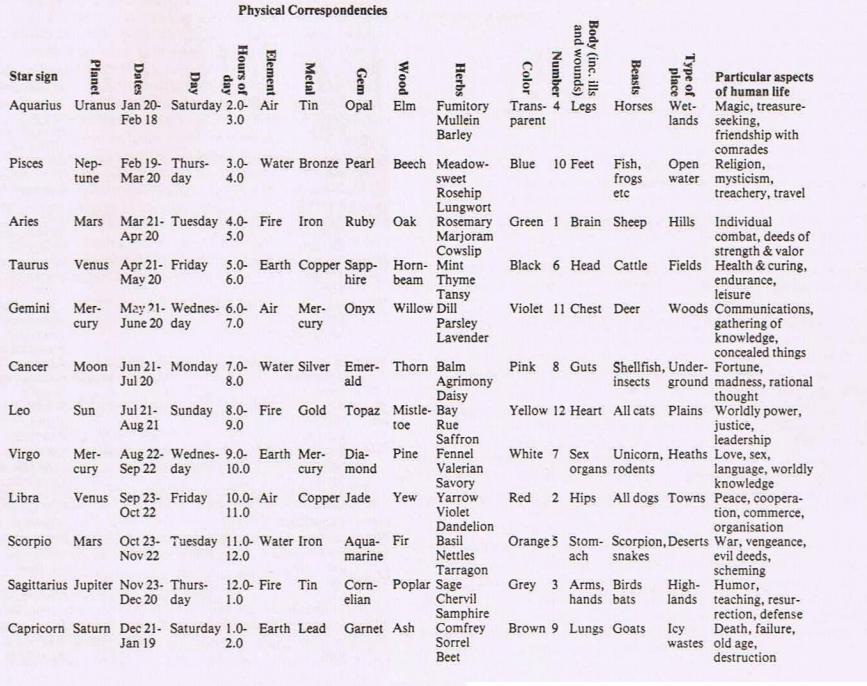
Ah ha ha, look at that motherfucker. Nowhere does it say which of these modifiers affect combat. Maybe if Joan engages in combat with some bandits on May 25th, Wednesday, at 6:34 am, while in the woods, she gets a -4 to physique and agility, possibly causing her to fall over and suffer a stroke. Maybe as a Sagittarius she can put a Poplar haft on a spear and get a permanent +1 to all stats. Maybe she gets a bonus to bat slaying and combat while she's cracking wise. Does she suffer a penalty to attacking an opponent who is wearing a wreath of Parsley? Does she get a bonus to attacking an opponent wearing a wreath of Sage? Do the herb bonuses stack, rendering her ineffective against someone who's stacked Dill, Parsley, and lavender? If they stack, can I throw a handful of the herbs that give me, personally, a bonus in combat at my enemies?
If she snorts some fennel, dresses in white, and sets out on a wednesday, does she get a bonus to kicking dudes in the nuts, or does that only apply to people born between August 22 and September 22?
My questions are never addressed.
The table is more commonly used for magic--it apparently is used in combat, but it's never really explained how. Basically, it is used to fish for bonuses. Because casting spells is a long and cumbersome process, the cunning mage waits for the day of the week in which his symbol is ascendant,
or the symbol of the person he is trying to link
, and stacks bonuses. So Joan, the level 1 witch, decides she wants to link up Chad Brohaus, a Leo. So she casts the spell on a Sunday, at eight in the morning, while chanting over a mighty bonfire of Poplar, Mistletoe, Sage, Chervil, Samphire, Bay, Rue, and Saffron, around which she has placed 3 tin bats painted grey and 12 gold cats painted yellow, on a mountain overlooking the plains, with a pair of rings, one with a Cornelian jewel, and the other with a chip of topaz. Also she tells a rude joke. Number of correspondences: 24. This boosts her casting level by +4. She also gets this bonus to any spells she casts through the link, but she may suffer a few minor penalties if she tries to do something like make him enter a wetands, or ask him to hide something. You know, -1 or -2 or so.
Chad Brohaus is probably linked. But a +4 only makes Joan effectively a level 5 caster, so let's see if we can improve this. After all, she would find it difficult to give him a hard command, so she can't simply order him to publicly yield his
dealership
trade guild to her and then commit suicide.
Incidentally, were he to try to attack her while she was standing next to this bonanza of random crap, his physique and agility would both be 10 higher due to the ten things boosting Leo, but nothing boosting Aquarius in the area. If a wizard is casting a spell on you, just throw a rock at him and watch him splatter against a wall.
The creation of Magic Devices
The game system hasn't even addressed what spells or commands can be cast through a link, and we're already into magic items.
Magic items are basically only for boosting spellcasting. Each magic item is one or more of the twelve zodiac signs, and gives a bonus from -2 to +5. Assemble the item dwarf fortress style out of the objects on the table, make a casting check against a difficulty equal to the number of elements.
Joan decides that she wants to be a more powerful caster. She starts by boosting Sagittarius, her personal star sign. She decides to craft a powerful artifact: "SamphireBlaze the Fire of Jupiter." This is a tin right gauntlet. All craftsmanship is of expert quality. It menaces with spikes of Poplar. It is enringed with Sage. It is ringed with Chervil. Engraved in Cornelian is a picture of three grey Bats flying over the Highlands. The bats are screaming. It was crafted on December 3, Tuesday, at 1 am. All told, there are 15 elements, which means Joan will have to pass a casting check at -15 on the table to make a magic item which would give her +4 to all spells. She fails.
Joan decides to set her signs a little lower, and enchants a ring of scrap tin with a bat on it. Because it has three elements, the casting check is at -3, which she succeeds at, and she gets a +1 ring. She makes four more. Now she has +5 to all spells forever.
She decides to follow this up by enchanting five bundles of mistletoe and Rue she's woven into little cat figurines. Returning to her bonfire of enchanting Chad, she reestablishes the link... a level 1 caster with an effective level of 15. The link succeeds, and Chad
There's a downside--you can't just carry around +5 to all signs forever, because they act as penalties to any spells you're casting on the opposite sign. But if you're trying to enchant an Aquarius, just set all your Leo boosting items aside--why not, casting a link takes an extended period of time anyway, spend the five seconds setting them down.
Anyway, the rules suggest that you can use the correspondence system to enchant any item to give you any bonus, so while she's tinkering at it Joan makes boots that give her a bonus to kicking people in the nuts (but penalize stomping on their feet), some pants that ensorcle horses (but anger cats) and a dousing rod that seeks out Dianmonds (but hides pearls from her sight). Should she ever need to stomp on a foot, deal with a cat, or find some pearls, she has the perfect plan--she will not use her magic items. While she's at it she gives herself a +5 defensive bonus with some more Sagitarius tin bats. Armor class isn't a thing in this game, but enchanted armoring items
is
so whatever.
Pity she can't participate in combat, she'd clean house. Even if she does look like she was thrown through a hot topic.
Fun fact: Because she made these items herself, if anyone else tries to use them they will actively try to kill that damn dirty thief.
Preparation for Sorcery / Accumulation of Mana
This section is how to refill your mana. The only interesting part is apparently you get three mana every day you don't get laid.
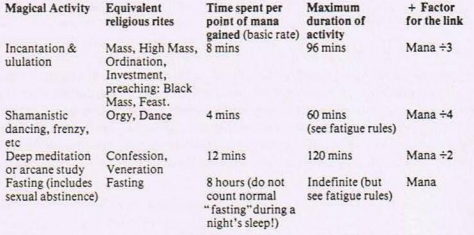
At least the rules for regaining mana are sim--
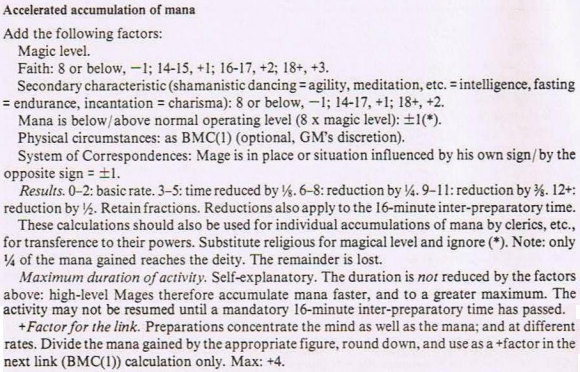
Nevermind.
Human Sacrifice
Stab a dude and get 1d6 + 6 mana. This a sin.
Pentacles
Pentacles are the only way to quickly cast a magic spell without going through the long, arduous, and boring process of establishing a link. They let you cast the spell, "Don't stab me!" at DD 3. This takes two pages to explain.
What does a Pentacle look like?

Thanks,
Fantasy Wargaming: The Highest Level of All
!
Conjuring
Most of this section is a long list of different things you can summon with random difficulties and how big a sin it is in the eyes of God. In short, summoning angels or yourself is a class 1 sin (worse than murder, rape, homosexuality) because it's the act of saying you're better than god. Summoning norse beings, demonss, elementals, stealing brains, reanimating dead corpses, or conjuring someone into themselves (huh) is a class 3 sin, which is to say that conjuring the explicitly evil and malevolent demons out of the hell that god has imprisoned them in and letting them loose on the earth unsupervised isn't as sinful as having two men touch dicks.
None of this is particularly hard, especially for someone decked out in cheap magical trinkets.
Spells
There are no specific spells, just guidelines for setting difficulty based on the type of effect you wish to cast. It is poorly laid out and all the effects are arbitrarily bound to a specific zodiac symbols, because. However, it isn't notably bad. Basically you choose your effect from a short list and roll on that dumb table to get a percentile to roll under, like every other spell.
Passive Magic
This is the first section someone's actually been interested in--the practice of magical understanding without action. Through observation without exertion of influence, a mage can divine information about his surroundings and the future. Instead of going through the process of establishing a link and then exerting a command, with all the assorted assembling of geegaws and consulting a half dozen tables, the mage simply observes the world around him or herself, maybe through a prop like a deck of cards, a crystal ball, or a pack of tarot cards.
The process of using passive magic is mechanically identical to the process of establishing an active magic link and casting an active magic spell at the same time.
The question you wish to ask is referenced on the following table.
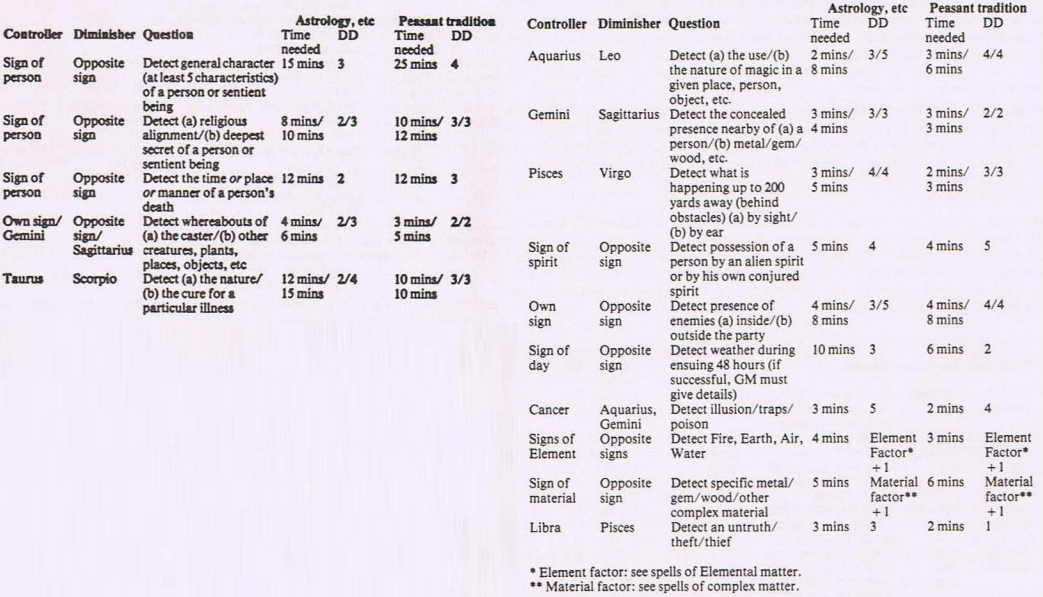
Of
course
making glorified perception checks is modified by the correspondence tables of astrology. Why wouldn't it be?
Dreams and Prophecy
In every other system I have ever seen, characters who dream about the future occasionally are given a dream by the DM for plot-related reasons.
In Fantasy Wargaming, players with a faith of 14 or higher add together faith and intelligence over 12, their mage level, their religious level, and up to +4 for the corresponding system
based on the kind of dream you'll have if you have a dream and the DM gives it to you
. This number is your percentage chance of having a dream each night.
Next time: Religious rules! Can you ask God for a pancake, or are you consulting the
purgatory duration
table?
Work off your Sins in minutes a day!
Original SA post
Those aren't bad magic rules.
These
are bad magic rules.
Fantasy Wargaming: The Highest Level of All
Chapter Seven: Work off your Sins in minutes a day!
Before I dive into the divinity section, I'd like to backtrack for a moment. I skipped all of the various types of spells, because they're all alike--some poorly defined effects, references to material not provided, and a half page of completely insane modifiers. I should have selected one to give you an idea of what they're like, and then skipped all the rest. Let's rectify that now.
Spells of illusion
quote:
DD depends on the size of the image, its monotony, its degree of animation and movement:
Size of the Image. Occupies under 1 percent of the field of view, -1; under 5 percent -1; over 10 percent +1, over 20 percent +2, over 40 percent +3, over 80 percent +4, the entire field of view (e.g. illusory landscapes), +5
Monotony of image . A uniform image, -1; one involving two or three colors and patterns, +1; many colors, patterns, pieces, +3.
Type of Image Inanimate, -1. Mixed, 0. Animal or monster, +1. Human or Etheral Spirt, +2.
Mobility of image. Immobile, -1; Moving, +2.
Familiarity of Image. Common sight, -1. unusual, +1. Totally new, +2.
Involves other senses as well as sight. +1 per extra sense deluded.
Controllers. Pisces, Gemini; Diminishers. Cancer, Aquarius.
The field of vision thing is a great example of how no playtesting was ever done. Do you have to cast again whenever someone moves closer to your illusion because the field of view has changed? Because mana expenditure is bound to DD, do you lose more mana as people approach your illusion? Why is there no default case for Mobility, Familiarity, or Monotony? If a spellcaster of level 2 or someone of faith 12 or higher automatically knows if a spell link is established, why would they ever fall for an illusion? Why do illusion spells have four correspondences, requiring the caster to check four goddamn rows on the correspondence table? Does the correspondance table affect the roll according to the contents of the illusion, making illusions of crabs hard and illusions of fish easy? If you make an illusion of only sound,how does the scope of the sound affect the DD?
These questions and many others are never answered. Note that unlike most spells, illusions do have a saving throw besides breaking the link... any person viewing an illusion has a flat 1 in 8 chance of breaking it. This chance is not modified by anything, ever. A leprous peasant (remember, leprosy: -1 to all rolls for 2d6 hours) is as likely to pierce an illusion as High Magus Oliver Cromwell.
All the spells are like this.
Anyway.
Religion
Appeals, Intercessions, and Miracles
I haven't even found out who I'm praying to and already the rules are talking about getting stuff from them. And how do you get things from God? Why, by adding up a big ole' list of modifiers, of course! Check out your faith, your divine favor, circumstances bonuses, the astrological correspondance (of course), her current piety band, the length of prayer, the presence or absence of a vigil, material sacrifice, if your request is in the wheelhouse of whoever you're praying too, if your benefactor has undergone papal sanctification, devil's influence, benefactor's long term goals, previous attempts, and assisting suplicants, then finally the +1 for using candles. Candles always give a +1, just... just have one on your hat or something. I don't care. Total everything up, subtract the difficulty of the miracle requested, roll for luck for the last modifier, and then consult yet another unique goddamn stupid table.
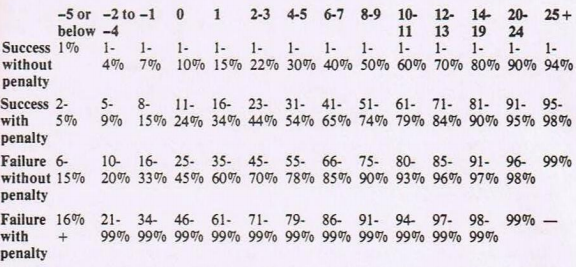
Now, some of you are happy that now, finally Joan of Sussex is good for something. She can't fight because she's a woman, she can't ever learn magic because she's a character--but her faith of 14 will help her call upon the various saints to bail her out of peril!
Well, no. Her faith of 14 gives her a +1 to her total, the same bonus as having a candle. A candle she probably can't afford as a quadruple slave, no less. So already Chad Brohaus and his candle is just as good at calling forth angels as Joan of Sussex is. Probably better, because he can afford a nice candelabra and get a regalia bonus, and maybe a half dozen hirelings to pray at his side for a tasty +5. Meanwhile, the terrible non-wizard Lord Magus Thunderfist with his faith of 2 is only at a -1. So when it comes to calling forth angels, believing in God is pretty unimportant. Sure, it helps. But then, so does a nice hat.
So, Joan's stolen a candle, prayed all night, out loud, without eating, to an appropriate saint who likes her and also she's covered in astrologically significant herbs and spices. What can she get with a good miracle?
She can ask where she is.
She can ask what the weather will be like.
She can ask what her piety stat is. (Don't you have to know this to invoke mira--oh, nevermind)
She can ask for a single specific piece of information about the future that may or may not be true.
She can ask what that rash is.
She can ask to be forgiven if there's no priest available to confess to.
She can ask for a -2 penalty to spells cast on her for a half day.
She can ask for a -2 bonus to her virtues for a half day.
She can ask for a -2 modifier to parry rolls.
And finally, three requests that don't suck.
She can ask to gain a piety band--to suddenly become a good person. By praying well, she gains piety as if she had been doing good deeds. Indeed, a good prayer a few times a day and God won't mind if you constantly engage in gay sex while shitting on the alter and burning down orphanages. Joan can also pray for this to affect all of her companions at once, so their constant arson is forgiven as well. This is pretty convenient!
She can ask for the saint in question to show up. Most saints are just, you know, dudes, and will be pretty useless, but a few are rampant badasses who will win a fight for you. Saint George springs to mind. Satanists pray to demons instead of saints, and they probably get the better half of this deal.
Finally, she can resurrect the dead. Note that this is pretty goddamn hard, but if she gets the five henchmen, doesn't eat for a few days, steals a candle or two, blesses herself, stays up all night in a church, and prays to someone known for resurrecting (like, I dunno, Jesus maybe) it's fairly simple for a level 0/0/0 character to resurrect anyone who's ever lived.
Religious Rank
This score varies from 0 to 10, and does nothing. You can use it to find out your title in the church, though: Clergy goes, "Clergy, Priest, Dean, Archdeacon, Bishop, Archbishop, Primatial Archbishop, Cardinal, Cardinal, Pope." Devil worshipers go, "Coven member, Assistant Coven Leader, Coven Leader, Coven Leader, Master of the High Coven, Master of the High Coven, Master of the High Coven, Master of the Grand Coven, Master of the Grand Coven, Anti-Pope."
Piety Band
Your piety goes up by 30 every adventuring day, and goes down whenever you sin. Doing good deeds does not influence your piety. As a devil worshiper, the same rules apply, but you want as low a piety as possible.
Here are some words I don't want to type.
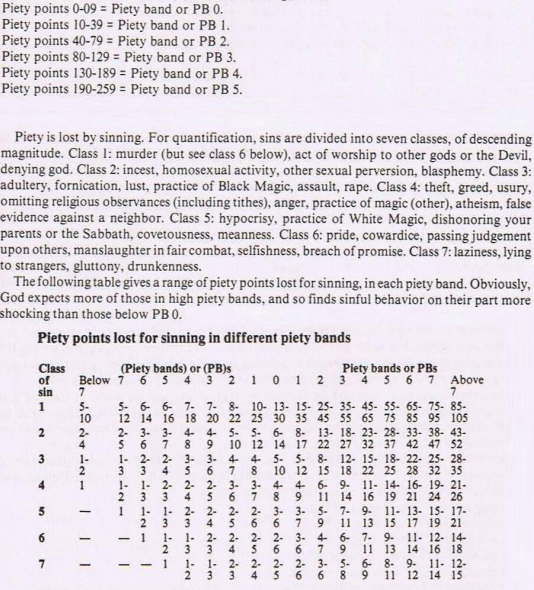
What does this mean? It means that sins depress your piety less and less the lower it is, so satanists find it difficult to lose piety, and the pious find it easier to lose a lot of piety for minor infractions. Once you hit rank 7, sleep in and you
Note that being lustful (not acting on it) is a class 3 sin, pretty major. Since Joan of Sussex has a lust of 11, above average for a man and high for a woman, we can safely say she's lustful every day. At piety rank 0, that's minus ten points out of her daily thirty. Toss on that the hit for her selfishness of 14, and she's already losing half her points every day to decisions made by her character sheet. Also, the rate at which she loses points increases if she manages to raise her piety--so if she hits piety band 2, she loses all of her daily piety every day, and more besides if she does any sinning at all... like, say, sleeping late, or using black magic to turn into a bear.
Fortunately, she can just pray to random saints to raise her piety band. Blammo, a full morning and she's rank piety rank 18 and ready to summon up some saints.
Satanists can't just pray for a lower piety band, but denying god is a class 1 sin that takes about five seconds. It might take a satanist a few days of screaming at the sky to drop his piety as low as Joan's is high, but it'll take much longer to revert to 0 then Joan's will. And then he can summon up demons to eat his enemies.
Clerical level affects nothing anywhere in this section.
Piety band and death
People of piety band 2 or higher go to heaven when they die. (Piety band) 2 or higher (why don't they just say -2?) go to hell. Other corpses consult the Purgatory chart ! I have simplified it.
( 10 - ( Piety + ( (ifFaith>>14)(1) ) + Luck + Indulgences ) ) * 50 years
Where indulgences can be any number from 0 to 4.
Becoming a Saint or a Demon
If your piety band plus your religious rank is 15 or more, you become a minor saint or demon. If your piety band plus your religious rank is 20 or more, you become a normal saint or demon. 25, and you become a major saint or arch-demon. You get a +1 to this check if you die in the service of God / The Devil, and a +2 if you're of high social class.
This has no affect on the game world for 5d100 years.
Spirits
So, given that the only thing you can really do with your clerical powers is summon forth saints and angels to win your fights for you, who can you summon?
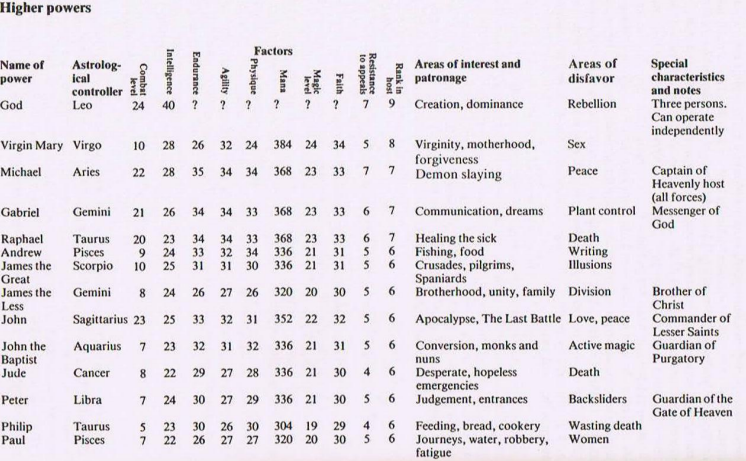
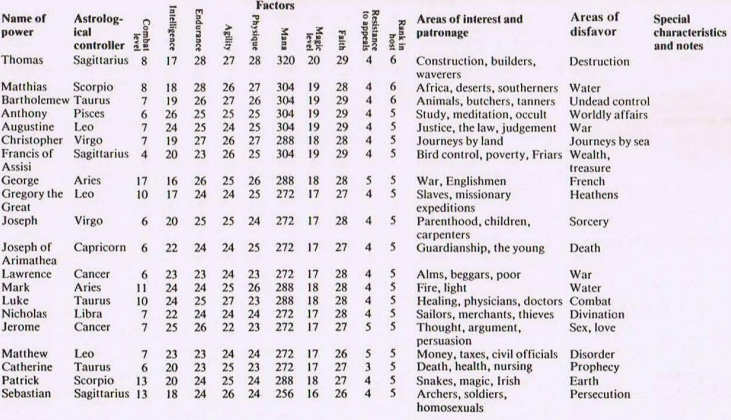
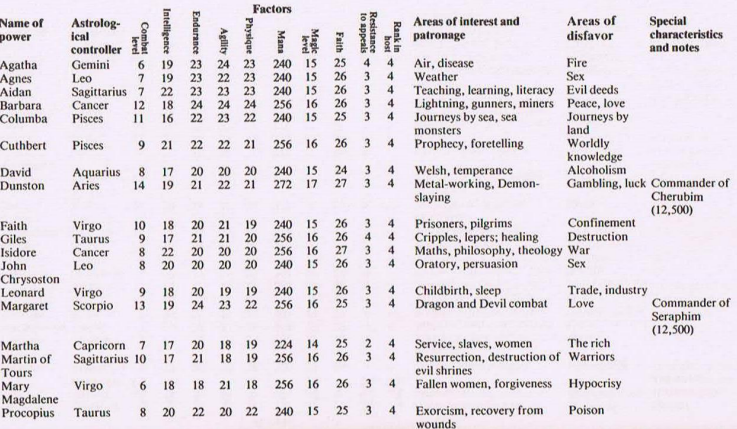
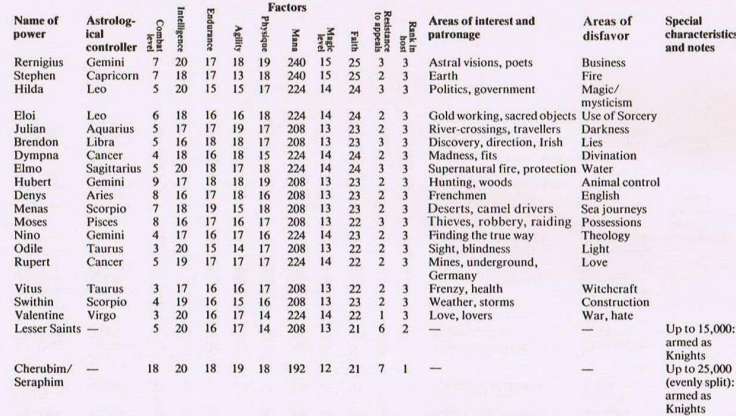
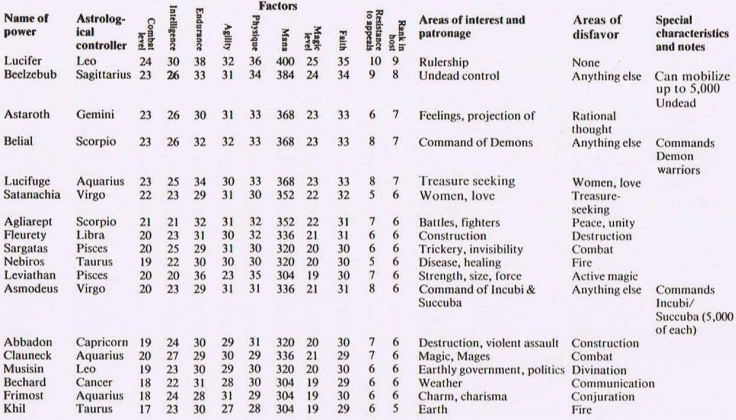
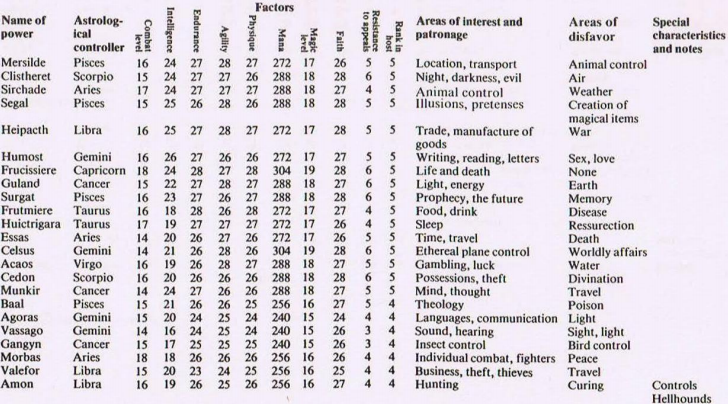
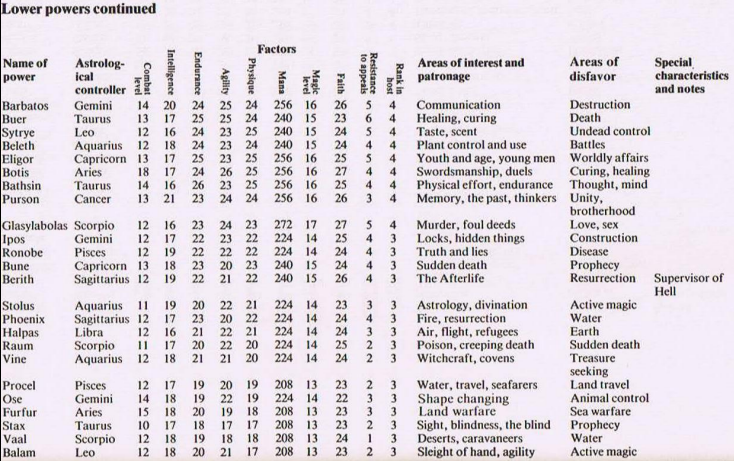
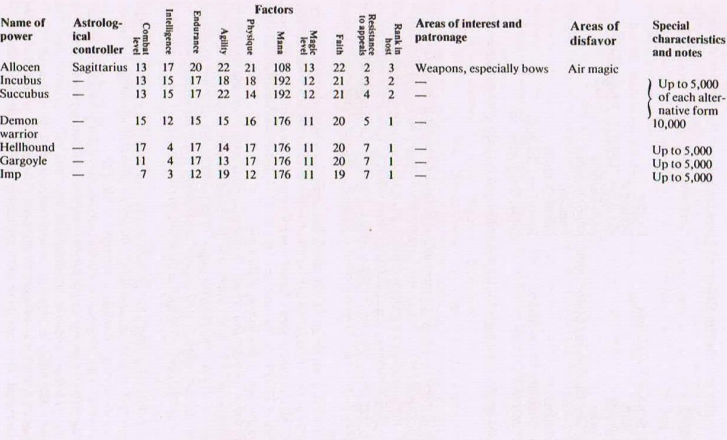
Them's some tables!
Example of Play
Lord Magus Thunderfist is crushed to learn that, as a level 0 character, he can never learn magic. In the grip of grief, he turns to devil worship, and screams defiance at the lord a few dozen times.
Joan of Sussex notices this happening, and decides to intervene. She's been boosting her piety through prayer, and even though she's a lustful selfish woman, she mysteriously has a piety band of 23, considerably higher than the pope's. She drops to her knees, throws up her hands in suplication, and summons John the Divine, keeper of apocalyptic knowledge and he who has seen how the world will end. A mighty level 23 warrior, second only to God himself in prowess, he is a mighty warrior, and he appears in a flash of golden light.
Lord Magus Thunderfist has been reading the rules, though, and he summons a lowly Demon Warrior. The lowest rank in hell, it is nevertheless a level 15 combatant. More importantly, Lord Magus Thunderfist summons ten thousand of them.
John the Divine doesn't like these odds, and takes a worried step back. Joan of Sussex has his back, though, and she conjures up Michael, Captain of the Heavenly Forces. Michael in turn calls forth every angel from heaven to fight this demon incursion--surely the endtimes have come to Sussex. But Lord Magus Thunderfist responds by summoning up Asmodeus and Beelzebub, who come with 5000 Incubi and Succubi, respectively, doubling the size of his force. As there's no cost to summoning, the ludicrously high piety of Joan and low piety of Thunderfist means they can both conjure basically every last being in heaven and hell. It's only a matter of time before they conjure forth God and Lucifer to fight like Pokemon for their amusement.
In reaction, Chad Brohaus sighs and says that as leader, he can declare the party's actions, and announces that the demons and angels are all banished back to heaven and hell by their summoners. Also, Joan and Thunderfist are to stop acting like assholes and come west with Chad, to investigate the rumors of bandits to the east. Since the two troublemakers don't have high leaderships, they have no chance to disobey.
Next time: Norse!
Who Formatted This Crap Anyway
Original SA postKavak posted:
German fencing could be fucking brutal.
And mark me as another one down for trying out 7th Sea.
From a few pages back, but I want to share a story with you fine gentlemen.
When I was six or seven, I was at summercamp, climbing a tree. The inevitable happened, and I wound up with a gash on my chin--about half an inch long, but deep and just gushing blood. The counselors unlock an unused camp building to have me lie down in, turn out the lights, call my parents, you all know the drill. I'm lying there with a borrowed shirt to bleed into, and I can't watch TV or anything because if I move around to much it might lead to disfigurement . The nurse is being very supportive, and she assures me that if I do need plastic surgery to remove the scar, it will be a very minor operation.
About half an hour later, Mom makes it from work. She looks down at me, smiles like she's won something, and says, "Son, have I ever told you about Heidelberg dueling scars ?"
I love you, Mom.
Fantasy Wargaming: The Highest Level of All
Still Goddamn Chapter Seven: Who Formatted This Crap Anyway
Let's wrap up with the clerical section. Remember that every character has three classes--adventurer, magic user, and religious figure. Experience for each class is accrued differently. Adventurer exp is gained for attempting checks, and is proportional to the percentage chance of failure, so you gain a level for every eighty attempts at a 50% likely activity. Also, you can gain adventuring exp by fighting. Mage exp is never gained and starting characters can't use magic. And religious exp is gained by holding religious ceremonies. A list of ceremonies you can hold, the relevant rolls, and their exp values is given.
This is a somewhat interesting idea, so let's punch some holes in it right now. First, only ceremonies held during an adventure count for exp, so any adventure in which you, oh, go to a town full of cultists or heretics doesn't allow you to advance as a cleric because no one will attend your ceremony. Furthermore, only ceremonies held during an adventure award exp.
Let's see how it plays out. Ottoman Davenport is the clerical wannabe of Joan's party, a pious, peaceful man who collects walnuts and has irresistible sexual appeal, thanks Bogey table. In one adventure, he decides to seize the reins and convinces Chad Brohaus to let him call the shots for a while.
Upon arriving in Fallowood, Ottoman introduces himself to the local pastor. He is invited to perform mass for the townsfolk to mix things up a bit, and agrees. After mass, he preaches for a solid hour and a half about the importance of confessing your sins. Finally, he grants benediction to the crowd. The rest of the party sits around impatiently as he holds confessions for the sinful townsfolk. But it pays fruit... one of the flock confesses to seeking solace from a heretical rite of harvest worship out of sorrow of his wife's death.
Investigating, they find out a corn cult is active in the town, practicing blood sacrifice to ensure a strong harvest! Enraged, Chad demands that the party stop this. When Ottoman asks how the rest of the party knows, Chad Brohaus announces as leader that Ottoman informs the rest of the party about the human sacrifice. Ottoman declares Malediction on the leader of the corn cult (sort of a formal curse, withdrawl of God's protection) but can't excommunicate him yet because he doesn't know who he is, and also he's not a bishop.
The party investigates, and finds out where the corn cult is holed up. The party knocks in the wall and engages the cowering cultists in bloody combat, which ends quickly when everyone on both sides quickly runs away screaming. Still, they've found out who the cult leader is--a man who lost his entire family to famine, and turned to heresy out of anguish. A bear mysteriously shows up, tears out his guts, and then leaves.
As the man lies dying on the floor, Ottoman gives him his Final Absolution... he's done evil, but so have all men, and through his intervention, the man's soul is saved, granting the cultist 2d6 x 10 piety. Then he dies. Exploring the lair, they find a young norse woman who was going to be used for human sacrifice, and her dead sister, who was already used for human sacrifice. Ottoman forcibly converts her, baptizes her, and finds a good young Christian man to marry her so she'll learn the proper way to live. Finally, a proper funeral is held for the dead sister, and a few prayers are made to bump her up a couple of piety tiers and maybe get her out of hell and into purgatory. Then it's handshakes and hot drinks all round!
So, we've just had an adventure run by the cleric, where every choice made was to maximize the number of divine ceremonies he gets to perform. How much clerical exp did he get?
Mass: 10
Preaching, 96 minutes: 12
Benediction, group: 0
Confession, 90 minutes: 2
Malediction: 4
Final Absolution: 4
Baptism: 6
Marriage: 8
Funeral: 8
Final total: 54 exp. He would have to run through nineteen adventures with similar levels of religious content. Also, no one else in the party gets any religious exp, because they weren't performing any rituals. Ironically, the young norse captive actually gained 60 religious exp, and is further on the way to level 1 than the young hero is.
However, everyone gets one third of their total piety gains as religious exp! As a christian, Ottoman gains 30 piety a day, and he loses about 20 of it because of forces beyond his control. That's an additional 3 exp! It will still take him nineteen adventures to level up.
Meanwhile, Joan, who's had nothing better to do besides a brief interlude as a bear, has been spending all day praying for divine inspiration. She's now at Piety Band 30, for a total of 5,100 piety points. She gains 1,700 exp and is level 1 in religion. Next adventure she does the same thing, advancing to piety band 60, for a total of 14,100 additional piety, boosting her to level 6 with her 6,400 total exp. The third adventure gains her 7,700 more, making her level 14. Ottoman is still 16 adventures away from level 1. Fuck you, Ottoman Davenport, Joan of Sussex is kicking your ass up and down the street!
The Norse!
Norse religion works mechanically identically to Christian or Satanic faith. A Norse worshiper doesn't even get different prayers--they can pray for absolution, divinity, and summoning exactly the same way that priests can. They get a different summon list, which is slightly less impressive in terms of sheer statistics, but has a more recognized list of fighters.
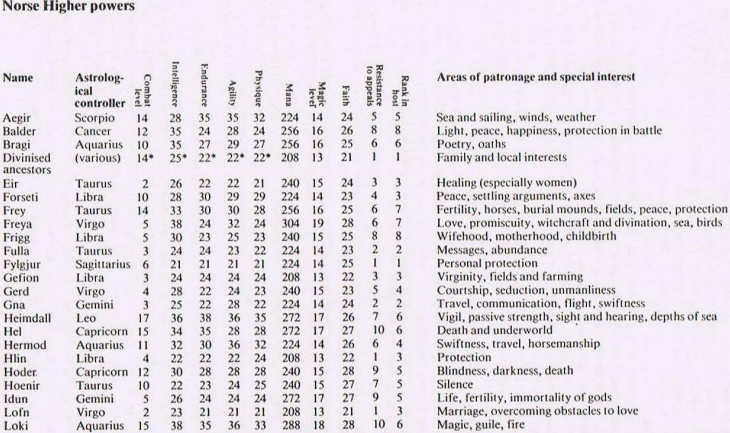
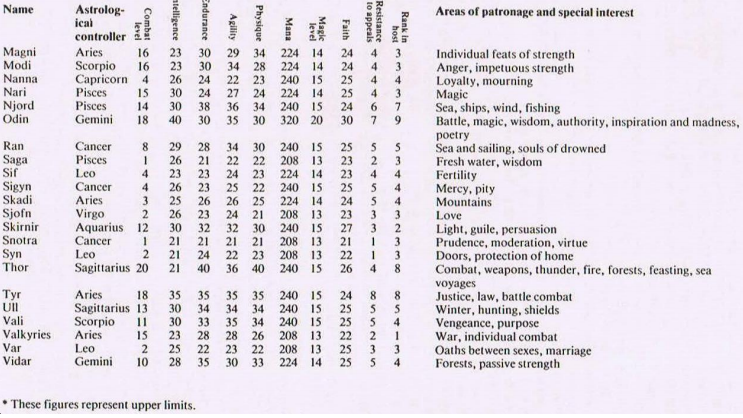
They do have a different set of rules for piety, though... no one automatically gains piety, but instead get it for performing virtues and lose it for sins. Norse virtues range from minor ones like leadership, obedience, and initative, and scale all the way up to grand generosity, upholding oaths at great personal cost, and heroism. Minor sins include anger, sloth, and selfishness, while major sins are breaking an oath, murder, and touching penises. Yup! Homosexuality is the same class 2 sin in the Norse calculations as it is for Christians or Satanists.
Also, murder is the greatest sin, really? I thought the Norse were all for rolling up on a dude, murdering him, and then partying all the way home, but apparently murder is an even greater sin for them than it is for the Christians. Huh!
Anyway, you can still artificially boost your piety band by praying to the various Norse gods for piety, sooooo who gives a fuck. The rest of this section is a list of the ways Norse trappings differ from Christian ones (different names for their ceremonies, the church only has three ranks) and we're on to the monsters.
Next time: Monsters! And then I'm done with this crap and can talk about Deadlands or something! Oh, thank God!
Ending not with a bang, but a whimper.
Original SA post Fantasy Wargaming: The Highest Level of AllChapter Seven: Ending not with a bang, but a whimper.
Monsters, magical beings, and general fauna
quote:
Size. There are five size grades, which generally get assigned according to head-to-toe length (what would be realtive height if all creatures stood erect). In the case of serpents and one or two other non-conformers this index is not a very good one,
Ah, self-awareness. What a rare treasure!
The size stat, of course, has no game effect. Same for the speed stat, which is only described in relative terms to a human.
All monsters have intelligence 2, greed and selfishness 14, lust 0, and bravery 12. Presumably, this means that when confronted with a wild bear, you can simply slip it a fiver and walk away. 5% of encountered monsters are infants, and 5% are senile--we've gotten into the Gygaxian naturalism part of the book, clearly. Finally, the book tells us only sentient races can have a faith or charisma score, and no magical creature has a piety score, because they have no soul.
Does a spellcaster who's cast summon self to become a magical creature lose his soul? What about God and Thor, as magical creatures are they unable to cast divine magic, which relies on your piety?
Anyway.
The remainder of the book is fifteen pages of monster entries. Each entry is a three or four sentence description of the beast in question, followed by its physical stats as if it were a player character. No rules are ever given for their special abilities, but otherwise this section is--not terrible! Mostly. Look, it's an uninspired list of medieval beasts, none of which are given enough detail to make them interesting, with no adventure hooks and no depth or unusual understanding. They read like Wikipedia stubs, but still this is fifteen pages of genuine, useable content, and it's largely free from creepy misogeny!
Unicorn posted:
It is goat-sized, with a white spiralled horn 15-30 inches long and a goat's beard. The approved method of capture is to entice it to put its head in the lap of a young virgin; later tradition piously teaches that this is because it is attracted by her purity, and wil placidly fall asleep in her lap, whereupon the harsh hunters may emerge and capture or slay it. Physiologus, however, informus us that, far from nodding off, the unicorn will begin to suck at her breasts and "cunduct himself familiarly" with her, at which point she must sieze his horn and hold him fast for the hunters. What would happen if the Unicorn were allowed to proceed further can only be conjectured; why not game it and find out?
OH TWILIGHT SPARKLE NO
So, uh, if these monsters are created and shaped by the belief of humans through the astral plane, why wouldn't the unicorn behave the way everyone said they would at the time period? Why is it acting in a more 'authentic' manner from a second century greek document, instead of the way medieval scholars said it behaved?
Anyway, I think I'll wrap up by holding a few more monsters up for example... there are sixty-one monsters total, all in all not a terrible bestiary.
Amphiptere posted:
Small winged serpent, highly maneuverable, with venom that will reduce victim's endurance by one point every quarter-hour until cured; lost endurance points are not recoverable. As there is no known medical cure, magic and prayer are all that will serve.
Physique, 1; Agility: 17, Endurance: 4; Combat factor: 1 (excluding venom); Size: tiny; Speed: fast; Society: nests; Armor class: 0, Method of attack: fangs; Sorce: heraldry
Hey, look, a monster that permanently cripples a character. This means it's poison is literally worse than the bubonic plague, leporosy, and being in a down moon all at the same time . No mention is made of the magic snake's traditional uses in folk remedies and magical cures or love potions--this book never gives information that would be useful for making an adventure.
Antelops posted:
The antelope of the bestiaries was a rather more fearsome specimen that the modern equivalent, being considerably more ferocious and sharper in teh horn. Like its smaller relative the Calopus, it had problems with its horns in undergrowth.
Physique: 12; Agility: 18; Endurance: 11; Combat factor: 10; Size: medium; Speed: Very fast; Society: herds; Armor class: 1 Method of attack: horns; Source: bestiaries
So, it's just a modern Antelope, but pointier? Do people still hunt it, is it hostile to humans, should we care about it? Who cares, onwards!
Black Men posted:
Not humans, but soulless sentient giants (up to 8 ft tall) with tough black skin and the arms of a warrior. They behave much like Celtic giants, and are usually non-magical but tricky.
Physique: 20; Agility: 17; Endurance: 20; Combat Factor: 13; Size: large; Speed: fast; Society: solitary; Intelligence: 7; Faith: 8; Magic level: 1; Greed: 12; Selfishness: 16; Lust: 12; Bravery: 18; Armor class: 2 (skin); Method of attack: armed or unarmed combat; Source: celtic, Arthurian.
Let's ignore the low-hanging fruit about the name, everyone. If they're usually non-magical but tricky, why do the default Black Men get a caster level and why are they stupid?
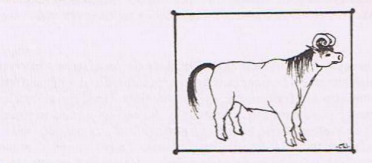
A few of the monsters have pictures! That's a Bonnacon.
Bonnacon posted:
A horse-like creature with a bull's head and extraordinary inward-curling horns that are consequently quite harmless. The Bonnacon is extremely timorous and will turn tail and run at the first sniff of trouble. Paradoxically, this is when he is most dangerous, for as the Bambridge Bestiarist tells us "when he turns to run away he emits a fart with the contents of his large intestine which covers three acres. And any tree that it reaches catches fire"
Then there are combat stats for the Bonaccon, in which it fights with its horns and could easilly kill a starting character. No rules are provided for the apocalyptic fart, what kind of damage it would do, the threshold for the saving throws, anything like that. Also the Bonnacon has the default bravery of 12. All in all, these are the stats for a dire boar, not a pyroclasmic fart goat.
Elves/fairies posted:
See earlier. Roll for characteristics if you prefer.
Physique: 15; Agility: 16; Endurance: 12; Combat factor: 8; Size: medium; Speed: average; Society: Kingdoms; Intelligence: 18; Faith: 24; Charisma: 20; Magic Level: 12; Greed: 12; Selfishness: 11; Lust: 15; Bravery: 12; Armor Class: 0; method of Attack: Armed combat; Source: all over sestern Europe before about 1350.
Why would you ever roll for charisteristics? Their stats are enormously higher than random number generation could possibly account for. Plus, every single elf is an arch-mage of incredible power, able to regularly create every magical effect in the book without stacking magical bonus equipment, but they're smart enough to know the advantages of stacking gear they can easilly make themselves. Plus, they are encountered in groups the size of kingdoms. Why don't they rule the planet? It seems like we should all be speaking elvish by now.
Also, what happened in 1350?
Werewolf posted:
Pysical characteristics as ordinary wolves (for which see below), mental as Mage's own characteristics in human form.
That's literally the entire entry. Of interest is the use of the word, "Mage"... does this mean that all were creatures are Mages? Should Joan of Sussex, a Werebear, get a mage level? Is she unable to enter bear form without casting magic? What's the difficulty of this spell?
All these questions, and dozens of others, are never answered. Fuck you, reader. Fuck you.
Finally, some animals.
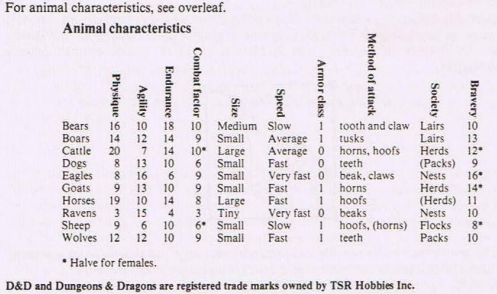
I'm not sure where Dungeons and Dragons was ever mentioned in this book. Still, I agree with animal stats being a forgotten subnote, because, who cares? If in your campaign you wind up in heroic combat against a sheep, you have more problems than needing its stats.
Let's end on a strong note. Look back at those monster stat blocks. You may notice that all the monsters have Armor Class scores.
Armor class is not a statistic in Fantasy Wargaming: The Highest Level of All, and has no impact on combat resolution.
Goodnight, everybody!
(If you have any questions, feel free to ask them, and I will give you all the answers the book provides)
